




































WELCOME TO THE AUTUMN EDITION OF GOODWOOD MAGAZINE. ese are some of our favourite months on the Estate, as high summer gives way to harvest time and mellow, golden days. Of course, it is also the season for Revival, our ever more ambitious celebration of all things vintage. As well as revisiting tales of bygone motorsport glory – and its heroes and heroines, such as the formidable Betty Haig (p78) – we are increasingly focused on the wider benefits of a world that doesn’t only value the new. Earlier in the year we hosted our first-ever vintage summit, bringing together leading voices who are championing the “pre-loved” fashion revolution. You can read their insights on style, sustainability and why the mainstream fashion industry needs to take note on p52.
We are especially delighted to welcome vintage tastemaker and burlesque pioneer Dita Von Teese to Revival this year. In e Goodwood Interview, she discusses her passion for vintage style, her car collection, and co-starring in a Taylor Swi video (p38). Staying with matters of style, our striking cover photograph of a Salvatore Ferragamo rainbow sandal from 1938 shows that great design never goes out of fashion, while Hannah Betts writes in praise of adding a touch of vintage flair to her wardrobe, all year round (p86).
Elsewhere, we delve into the story of that much-loved Californian classic, the Meyers Manx dune buggy. e company has just unveiled its first allelectric model and we will be helping to celebrate 60 years of this pop culture icon at Revival. Eighty years on from the D-Day landings, we also tell the story of Sussex at war and living on the unlikely South Coast frontline, while also dipping into the extraordinary life of war photographer Lee Miller, former Sussex resident and now the subject of a new feature film.
Looking forward to our upcoming autumn health summit, we learn all about the “baby biome” and the vital importance of early nutrition. And finally, because we love a party here at Goodwood, our fashion shoot (p68) showcases the most glamorous of ballgowns in the most bucolic of settings… down on Goodwood Home Farm, with some furry co-models.
We look forward to seeing you at Goodwood soon.


Doug Nye
Doug helped to found FOS and is one of Britain’s best-known authorities on motorsport. He has written more than 70 books on the subject, as well as conveying his passion for the sport and its history as a television presenter and expert consultant. He shares his memories of driver John Surtees on page 22.

Alexandra Harris
An author and academic with an interest in the way art and culture contribute to a sense of place, Alexandra’s new book is e Rising Down: Lives in a Sussex Landscape. For this issue, on page 34, she reflects on the remarkable work of English landscape painter and poet George Smith and the “Smiths of Chichester” trio of artists.

Joanna Wolfarth
Joanna is the author of critically acclaimed book Milk: An Intimate History of Breastfeeding. For this issue, on page 92, she interviews pioneering infant health scientist Dr Sioned Jones, one of the speakers at September’s Goodwood Health Summit, about advancements in our understanding of breast milk.

Josh Shinner
Photographer Josh Shinner has created images for clients ranging from e New York Times to Disney, Nike and the Prince and Princess of Wales (shooting their 2023 family Christmas card). He donned his wellies to photograph our fashion story at Goodwood Home Farm. e results can be seen on page 68.



Julia Llewellyn Smith
For this issue’s e Goodwood Interview, Julia – who writes for titles including e Times and e Telegraph – sits down with a vintage expert: Dita Von Teese. Ahead of Von Teese’s attendance at Goodwood Revival, the pair discuss her unlikely path from small-town girl to legendary burlesque performer on page 38.

Sarah Bailey
A writer, editor and podcast host, Sarah has been at the forefront of fashion journalism for many years. She is the former editor-in-chief of Elle UK, Red and PORTER, and is currently international editorat-large for Vogue Greece. On page 52 she takes us inside the first ever Future of Vintage Summit at Goodwood.
Editor
Sophy Grimshaw
Art director
Vanessa Arnaud
Editorial directors
James Collard
Gill Morgan
Creative director
Sara Redhead
Designer Camila Rivero-Lake
Sub-editor
Damon Syson
Picture editor
Sharon Martins
Project director
Sarah Glyde
Goodwood creative director
Will Kinsman
Goodwood brand projects
Jennie Gott
Goodwood
junior picture editor
Max Carter
For all advertising and editorial queries, please contact Goodwood via magazine@goodwood.com
Goodwood Magazine is published on behalf of The Goodwood Estate Company Ltd, Chichester, West Sussex PO18 0PX, by Uncommonly Ltd, 30-32 Tabard Street, London, SE1 4JU. For enquiries regarding Uncommonly, contact Sarah Glyde: sarah@uncommonly.co.uk © Copyright 2024 Uncommonly Ltd. All
permission from the publisher. While

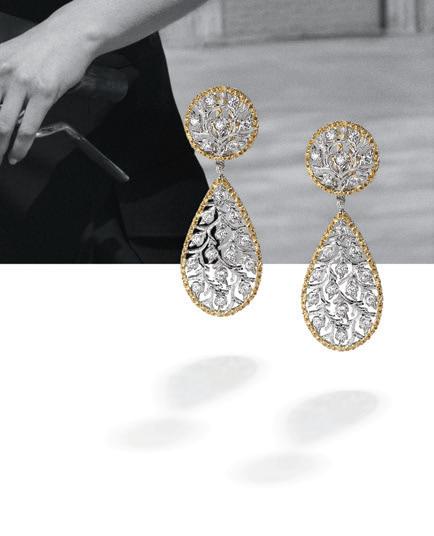
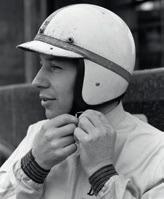
“ I grew up thinking I was going to marry Prince Charles, watching the Royal Wedding on television”


No matter how much the car changes, one thing stays the same: the feeling of Mercedes-Benz. DEFINING CLASS since 1886.

DEFINING CLASS since 1886.

“SOMEWHERE OVER THE RAINBOW,” promised a fresh-faced Judy Garland in The Wizard of Oz (1939), “skies are blue.” Though her character, Dorothy Gale, was a little girl, at the time of filming Garland was already 16 and a nascent movie star, with a background as a professional singer. The shoes with which the film is indelibly associated are, of course, Dorothy’s ruby slippers. One year earlier, however, in 1938, Italian “shoemaker to the stars” Salvatore Ferragamo had crafted Garland a pair of rainbow-coloured suede-covered sandals that would also become iconic. Known as the creator of the wedge shoe, he added a 8.5cm cork heel to raise the 4’11” Garland up in the world, and she was far from the only woman who took a liking to them – so much so that an updated version of this shoe remains in production. Part of its enduring success was down to Ferragamo taking great care to ensure that this most fabulous of sandals was also surprisingly comfortable to wear, almost like “being barefoot”.










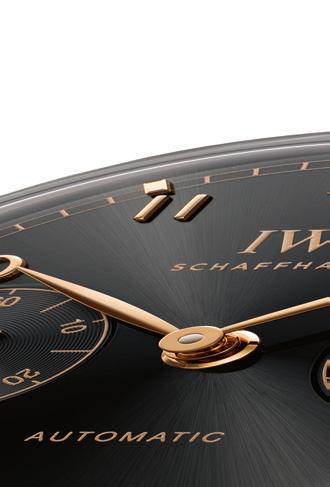






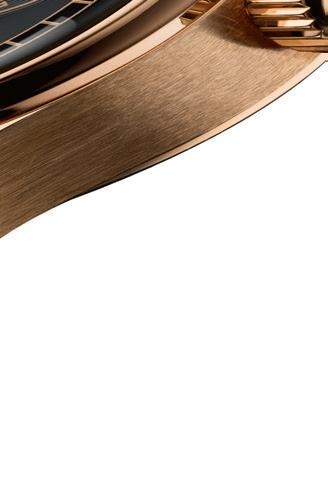
Portugieser Automatic 42, Ref. IW501707
Conceived 85 years ago as an instrument watch with marine chronometer precision, the Portugieser has evolved into a timeless yet dynamic paragon of understated elegance. A slimmer case now makes the Portugieser Automatic 42 even more refined, while double-box glass sapphire crystals showcase the IWC-manufactured 52011 caliber with a power reserve of 7 days and the elaborately crafted dial in a new colour called Obsidian. IWC. ENGINEERING BEYOND TIME.





Noted: people, objects, news and ideas, from planting wildflowers and remembering John Surtees to the return of Granny Takes a Trip
WORDS BY MATTHEW DAVIS
For seven weeks, David Hurn chronicled the Beatles’ lives at the peak of their fame, including these quieter moments at Abbey Road Studios

It’s 1964, the height of Beatlemania, and the Fab Four are a band on the run – desperate to avoid a horde of fans as they take the train to London to film a televised concert. This is the starting point for A Hard Day’s Night, the band’s playfully subversive first feature, directed by Richard Lester. Powered by classic tunes such as the title track and Can’t Buy Me Love, it is widely regarded as one of the all-time great music movies.
Chronicling events on and off set was David Hurn, who was asked by Lester to act as a special photographer –“not for press, but more from a sociological point of view”. He spent seven weeks with the Beatles, witnessing the feverish excitement that accompanied their every move. The Liverpudlian quartet were a smash hit here and across the pond: during the filming of the movie, they simultaneously occupied the top five slots on the Billboard Hot 100 singles chart, a feat that has never been repeated.
These shots of the band at Abbey Road Studios, taken in March 1964, reveal their serious, studious side, far removed from the goofy antics that characterise the film. “They’re the
biggest band that has ever been and I suspect they had the most ludicrously fanatical fans ever, too,” Hurn recalls. “The effect it had on four young guys must have been enormous.”
Hurn never looked back after his time with the Beatles, joining the illustrious Magnum photographic co-operative in 1965. Today, at the age of 89, he reaches new audiences on Instagram, dispensing images and thoughts on a glittering sixdecade career. Yet photography was the last thing on his mind when he was growing up in Cardiff – he hoped to become a vet, but dyslexia meant he left school without any qualifications. As an army cadet at Sandhurst, he experienced a life-changing moment while flipping through Picture Post magazine. A photo of a Russian army o cer buying his wife a hat in Moscow triggered memories of his parents’ reunion after VE Day and made him look beyond the postwar propaganda: “I instantly realised that all Russians don’t eat their children,” he recalls of that day. He had discovered the power of the photograph. A print of this contact sheet is available to buy, from £280, at store.magnumphotos.com



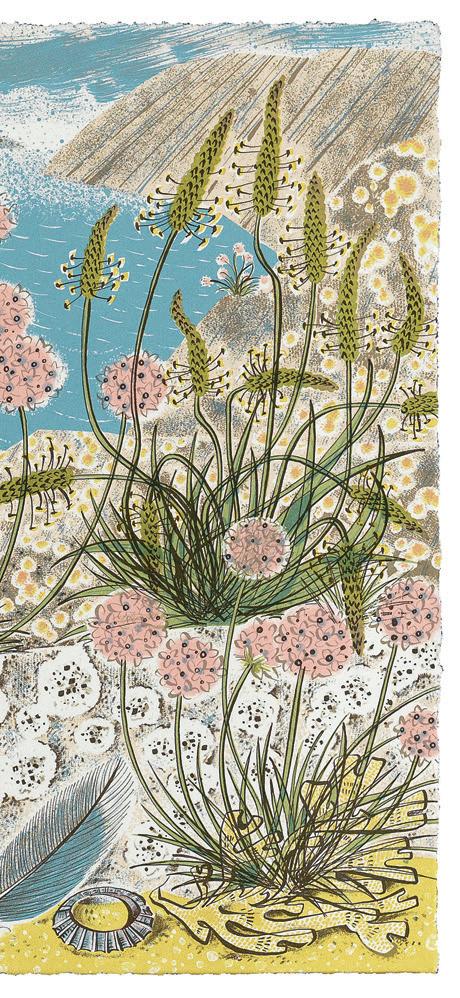
An ambitious new illustrated guide brings British wildflowers to life, but how hard are they to grow for yourself?
Goodwood has always embraced the beauty of wildflower meadows, creating sustainable environments that are ideal for their growth. Today, more than 100 different species of wildflower flourish across the Estate, from cow parsley to orchids. If you have a garden or meadow that can sustain them, autumn is a prime time to plant wildflower seeds, ready for them to bloom the following summer. In the meantime, a lavish new illustrated guide, The Book of Wild Flowers, brings 21 examples to life in the distinctive linocut style of celebrated British illustrator Angie Lewin.
The book’s co-creator is her fellow flower enthusiast, writer Christopher Stocks. “Everyone wants a wildflower meadow these days, but creating one is harder than it seems,” he says. “Wildflowers evolved to grow in far harsher conditions than those of our gardens. Often, they can’t compete with the vigorous grasses that thrive in rich, well-watered soils.”
This leaves any would-be wildflower enthusiast with two options. The first, Stocks advises, is to reduce the fertility of your soil, “by scraping off rich topsoil and planting yellow rattle, a pretty but semi-parasitic plant that preys on grass and saps its strength”. If that doesn’t appeal, “a number of firms supply ready-made wildflower turf, which can be rolled out to create an instant wildflower meadow. Hardened horticulturists might regard it as cheating… but it all depends how much trouble you want to go to.”
Stocks’ own favourite wildflowers include Alexanders, which “probably arrived in Britain with the Romans. Like the Romans, they never really established themselves north of the Border, and their acid-green foliage and flowers can mostly be found around the coasts of South West England.”
In his view, “arguably the most beautiful of all our wildflowers is the snake’s head fritillary”. This rare bloom has a drooping purple head with an extraordinary chequered pattern on its petals. “They probably arrived in England some time before 1597, when John Gerard included them in his book, TheHerball,” says Stocks. “They then spread with the construction of water meadows during the 17th century. Today, they’re only found in a few remaining meadows, but they’re a spectacular sight.”
The Book of Wild Flowers: Reflections on Favourite Plants by Angie Lewin and Christopher Stocks is out now (£16.99, Thames & Hudson). Goodwood Magazine readers can enjoy a 35 per cent discount with the code WILDFLOWERS35, at thamesandhudson.com/wildflowers

Rolls-Royce Spectre WLTP: Power consumption: 2.6 – 2.8 mi/kWh / 23.6 – 22.2 kWh/100km. Electric range 311 - 329 mi /500 - 530 km. CO2 emissions 0 g/km.
Official data on power consumption and electric range is determined in accordance with the mandatory measurement procedure and is compliant with Regulation (EU) 715/2007 valid at the time of type approval. The figures shown consider optional equipment and the different size of wheels and tyres available on the selected model. Changes of the configuration can lead to changes of the values. For vehicles that have been type-tested after January 1st, 2021, the official information no longer exists according to the NEDC, but only according to the WLTP. Values are based on the new WLTP measurement procedure. Only compare power consumption and electric range figures with other cars tested to the same technical procedures. These figures may not reflect real life driving results, which will depend upon a number of factors including the starting charge of the battery, accessories fitted (post-registration), variations in weather, driving styles and vehicle load. Further information about the official fuel consumption and the specific CO2 emissions of new passenger cars can be taken out of the “Guide to Fuel Consumption, CO2 Emissions and Electricity Consumption of New Passenger Cars”, which is available at all selling points and at https://www.gov.uk/co2-andvehicle-tax-
WORDS BY MATTHEW DAVIS
The appeal of a well-crafted pedal car to successive generations shows there’s no driver too small for the thrill of the race
There are pedal cars, and then there’s the Austin J40. This icon of timeless automotive style in miniature was created in the 1940s and is now put though its paces every year at Goodwood Revival. One of the most fiercely contested races of the entire weekend, the Settrington Cup sees mini-motorists sprint to their brightly coloured vehicles and pedal down the Pit Lane Straight – at a searing average speed of 7mph.
More than 32,000 J40s were built between 1949 and 1971 at the Austin Junior Car Factory in Bargoed, South Wales, where the workforce consisted of former miners suffering from lung damage.
Fashioned from offcuts of metal left over from production at Austin’s Longbridge factory, and modelled on the 1948 A40 Devon and Dorset, these shapely toy cars came with working headlights and horn, detachable wheels with Dunlop tyres, chrome bumpers, a realistic fascia panel and leather or cloth seating.
Still loved by children and classic car collectors alike – the finest examples sell for more than £10,000 – the vintage vehicle is now enjoying its own revival since the launch of the Settrington Cup in 2012, supported by Austin Pedal Cars, which specialises in J40 sales
and parts. Its bespoke J40 Continuation model is the first new Austin pedal car produced for more than 50 years. It combines classic looks with a technologically advanced pedal and steering system.
From the hand-formed aluminium bodywork to the woodenrimmed Moto-Lita steering wheel and an electronic dashboard by Smiths – which made gauges for classic British cars – the J40 Continuation has a feel of exclusive luxury about it. Every car will be built to order, with unlimited paint options and an extensive selection of interior materials and designer fabrics: Austin Pedal Cars collaborated with the prestigious fabric merchant Holland & Sherry to create a lavishly upholstered J40 Continuation in a striking turquoise hue for the 2024 Concours on Savile Row in May.
Austin boss Sir Leonard Lord, who came up with the idea for the J40 in 1946, would no doubt be thrilled to see his brainchild recreated in such high style – though he might raise a postwar austerity eyebrow at a price tag that sits in the region of £25,000.
The original J40 sold for £20.
The Settrington Cup takes place on Saturday and Sunday during Goodwood Revival, which runs from 6-8 September 2024
Below: Settrington Cup racers prepare to put their feet down

Ahead of Goodwood’s celebration of driver John Surtees, a seasoned motorsport writer remembers him

WORDS BY DOUG NYE
John Surtees was the only man in history to win world titles on two and four wheels. He was motorcycle-racing World Champion seven times, Formula 1 World Champion once, inaugural Can-Am champion, a Formula 1 team founder and principal. He was also the most competitive person I’ve ever known, which speaks volumes when you consider that I’ve worked with Stirling Moss, Jackie Stewart, Juan Manuel Fangio and so many more. Such deep-rooted competitiveness made him a decidedly Marmite personality. His father, Jack, was a South London motorcycle dealer and sidecar racer. John won his first race as his dad’s passenger, only for the pair to be disqualified because Surtees junior was only 14. At 15 he began grasstrack solo racing. At 16 he became a Vincent motorcycle factory apprentice. Through the early 1950s his innate racing talent blossomed.
In 1955, as a works Norton rider, Surtees beat contemporary superstar Geoff Duke. By 1956 he was snapped up by MV Agusta of Italy and won the 1956 500cc World Championship. Between 1958 and 1960 he won 32 of his 39 races, plus six more world titles.
When Count Agusta cut back, Surtees turned to cars, first with a Ken Tyrrell-entered Formula Junior Cooper at Goodwood in March 1960, then with his own Coopers, before Colin Chapman gave him an F1 Lotus drive, which resulted in Surtees finishing second in his first British Grand Prix – all within the space of four months and all while securing the 350cc and 500cc motorcycle world titles. He found his F1 feet with private Cooper and Lola entries in 1961-62, was signed by Ferrari in ’63 and was F1 World Champion in ’64. He later won Grands Prix for Cooper-Maserati and Honda, while his own Team Surtees operation went on to build Formula 5000, then F1 and F2 cars. It was in these that Surtees won non-Championship F1 races twice in 1970-71 before retiring from driving in ’72.
Surtees – who, in 1993, became a patron of the first Festival of Speed –was a true global motorsport great. His intense and single-minded approach earned him few friends throughout his career, yet in his relaxed moments he could be friendly, engaging and helpful. That was the John Surtees I knew. John Surtees will be celebrated at Goodwood Revival, 6-8 September 2024

Fuel economy figures and CO2 results for the new BMW M5 Plugin Hybrid: Mpg (l/100km) combined: 177.6 (1.32) – 188.3 (1.25). CO2 emissions: 35 g/km. Equivalent allelectric range: 46.0 to 46.6 miles. These figures were obtained using a combination of battery power and petrol fuel. The BMW M5 Saloon requiring mains electricity for charging. These WLTP figures are shown for comparability purposes. Only compare fuel consumption, CO2 and electric range figures with other cars tested to the same technical procedures. These figures may not reflect reallife driving results, which will depend upon a number of factors including the starting charge of the battery, accessories fitted (post registration), variations in weather, driving styles, fuel type and vehicle load.

WORDS BY ALICE NEWBOLD
Legendary 1960s boutique Granny Takes a Trip is back –with a point to prove about overconsumption
Picture the scene: it’s 1966, London has just been declared “swinging” by Time magazine, and a wild patch of renegade shops is sprouting up at the rock ’n’ roll end of King’s Road, dubbed World’s End. Among them is Granny Takes a Trip, a boutique so psychedelic that customers had to side-step the protruding bonnet of a Dodge car and a cloud of incense to find the opulent clothes. No nanna would have approved of what went down in the gallery-style space frequented by Pattie Boyd and Marianne Faithfull, the Rolling Stones and the Beatles, but that was precisely the point: to make shopping electric.
Some good news for those feeling disillusioned with fashion’s current shaky retail landscape: Granny – who bowed out on a mini-skirted high in the late 1970s – is back with the same attitude that earned her a place in Mick Jagger’s heart. “Pretty laid back” is how co-founder Nigel Waymouth describes the store’s original free-spirited policy, which has now been funnelled into a retro-leaning website. “People would come in and nose around – and that’s how we liked it.”
The graphic designer originally dreamed up the shop as a solution to the heap of vintage clothes on his then girlfriend Sheila Cohen’s bedroom floor, but when mod tailor John Pearse joined the crew, their inventive, upcycled adaptations of the strict uniform of the decade took off. “We were trying to give people their own personal identity and self expression,” explains Waymouth of the colourful romanticism at the heart of Granny, characterised by floral silk shirts, crushed velvet suiting and the mini-est of dresses pieced together from old upholstery and wall hangings found on Portobello Road.
2024’s digital Granny expands that core sustainability principle of making magic out of waste with directional garments crafted from unique deadstock, cool rentable pieces made out of forgotten music industry merch, and an in-house buy-back scheme that it hopes will lead to collaboration and further experimentation. The beloved boutique’s modern-day answer to overconsumption is all about creating a shared archive. “Style,” its manifesto a rms, “isn’t confined to ownership.”
Visit the new shop’s site at granny.london


The soil beneath Goodwood is rich with Roman artefacts and, as recent archaeological surveys have shown, there’s still more to unearth
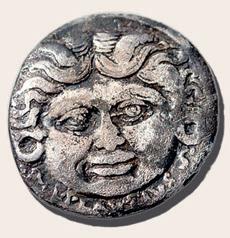



WORDS BY ALEX MOORE
When Rolls-Royce Motor Cars started to plan an extension to its plant on the Goodwood Estate, the firm commissioned a November 2023 archaeological survey of the site conducted by Oxford Archaeology. The work of these independent experts revealed some startling finds that would need to be sensitively recovered before building begins. Some 20,000 artefacts were discovered, including Roman roof tiles, traces of human fingerprints, animal paw prints, pigs’ teeth and pottery. The finds are currently undergoing further study and cataloguing to develop a more detailed picture of life in the area over the past two millennia, but, according to Mark Dodd, who led the dig, one early hypothesis is that the site was once used for metal-working activities.
“We are a small part of the long history of Westhampnett,” says Andrew Ball, head of corporate relations and heritage for Rolls-Royce Motor Cars, referring to this particular corner of Sussex. “This archaeological survey is providing new insights into the fascinating story of the area that surrounds us, and we look forward to sharing these artefacts with our neighbours later this year.” In the meantime, a local school was invited to the site, allowing children to unearth pieces alongside the archaeologists.
The excavation prompted by Rolls-Royce is not the only recent discovery in the area. Earlier in 2024, a survey commissioned by a property developer revealed the remains of a Roman settlement in the West Sussex village of Tangmere. A team from University College London is now set to excavate that site for the next three years.
It makes perfect sense that Sussex soil should be rich in Roman finds. In 43CE, some 40,000 soldiers arrived in Noviomagus Reginorum (Chichester) to set about incorporating Sussex into the Roman Empire. Under the watch of Tiberius Claudius Togidubnus, king of the Regni tribe, Fishbourne Palace – which is by far the largest Roman residence known north of the Alps – was constructed nearby. As was Bignor Roman Villa, which is home to some of the finest Roman mosaics anywhere in Europe. Both are visitor attractions for the area today. It could be that there’s plenty of the story still left to unearth.
WORDS BY MARK HOOPER
The ancient harvest tradition of making corn dollies is one of many crafts enjoying an unlikely revival
Ubiquitously stocked in countryside attraction gift shops, corn dollies might appear to be little more than quaint decorations. In fact, these intricately designed miniature sculptures were originally created to be the repositories of the corn “spirit” that was believed to inhabit each seasonal crop of corn or wheat. At harvest time, the last sheaf to be cut would be fashioned into a hollow, plaited shape, inside which the spirit could survive until the following autumn.
As Simon Costin, director of the Museum of British Folklore, notes, “These objects carried within them the hopes of the following harvest.” The dollies would be taken to a notable home or a place of worship until the next crop was planted, when they were buried back into the soil, returning the spirit to the earth. Costin emphasises that the cultivation of wheat marked a defining point in modern civilisation: “It marked the transition from a nomadic culture to a static culture.” The sowing and tending of crops, and the seasonal regeneration of nature, was celebrated in ancient religious ceremonies, often embodied in goddess figures such as Isis and Demeter.
“Nearly all traditional harvest corn dollies have something of a Mother Earth feel about them,” explains Cristina Best, who donated her
large collection of corn dollies to the Museum of British Folklore. “She is responsible for the growing of new crops in the next season.”
Best’s collection shows that this pagan tradition extended not only throughout the British Isles, but also across Europe, the Americas, Africa and the Middle East. Corn dollies are thought to originate from Ancient Greece, while the oldest design in her collection is the Arabic Cage, examples of which were found in Egyptian tombs.
Today, with corn dollies featuring on the Heritage Craft charity’s “Red List” of endangered skills, there has been an unexpected revival. The Weald and Downland museum offers well-attended corn dolly weaving workshops, while the designs have captured the imagination of contemporary artists including Victoria Musson and Alastair Mackie.
As Helen Armstrong, an artist and designer who has included the symbolism of corn dollies in her work, explains, these objects illustrate “the relationship of our human hands with a magical connection to the land we inhabit – through traditional crafts that have served us from the beginning.”
Discover a variety of traditional crafts showcased at Goodwood Revival, 6-8 September 2024



WORDS BY GILL MORGAN
A new film starring Kate Winslet recalls the extraordinary life of photojournalist and former Sussex resident Lee Miller
When model turned photographer Lee Miller died in 1977, her daughter-in-law was clearing out the attic of the family’s Sussex home, Farleys House, when she discovered a box. Going through it with her husband, Anthony Penrose, they were amazed by its contents: a cache of 60,000 prints and negatives – Miller’s lifetime’s work. As Penrose says, “I didn’t realise it at the time, but it was a life-changing moment.”
His mother never talked of her life and its many remarkable achievements, nor of the terrible things she had witnessed. He simply knew her as di cult: “I’d dismissed her, written her off as a useless mother,” he starkly explained in a recent interview. Now he began to understand why. Penrose turned this filial voyage of discovery into a book, The Lives of Lee Miller, upon which the new film, Lee, co-produced by and starring fellow Sussexite Kate Winslet, is based. He also set about creating an archive and museum at Farleys, dedicated to her life and work. “The Lee I discovered was very different from the one I had been embattled with for so many years,” Penrose wrote in the postscript to his book. “I am left with the profound regret that I did not know her better.”
Born in 1907 to a wealthy family in upstate New York, Miller became a Vogue model at 19, but was always more interested in being behind the lens. She moved to Paris to work at the
studio of surrealist photographer Man Ray, who became her mentor, lover and eventually her friend. Life was one of haute bohemia: she also became friends with Picasso and Miró, and went on to pursue her own photographic career.
By 1939, Miller was living in Hampstead with the British surrealist artist and curator Roland Penrose. When war broke out, she persuaded Vogue to hire her as a photojournalist, going on to capture London during the Blitz, the liberation of France and, eventually, the first photographic evidence of the atrocities of the Nazi concentration camps. It was this relentless, boundary-busting spirit that Kate Winslet had long admired, having read Penrose’s biography a decade ago.
After the war, the family moved to Farleys, in the bucolic location of Muddles Green near Chiddingly. Nothing could have been further from the horrors Miller had witnessed, but the ghosts – now understood to be PTSD – came to haunt her. Suffering from mood swings and drinking heavily, she was an often unhappy presence. Yet thanks to the tenacity of both mother and son, her work is better known today than it has ever been. As Penrose, now 77, says, “My mother had a saying: ‘You can say anything you like, as long as it’s the truth.’”
Lee is in cinemas now. Farleys House & Gallery is open to the public until 24 October 2024 and will reopen in spring 2025

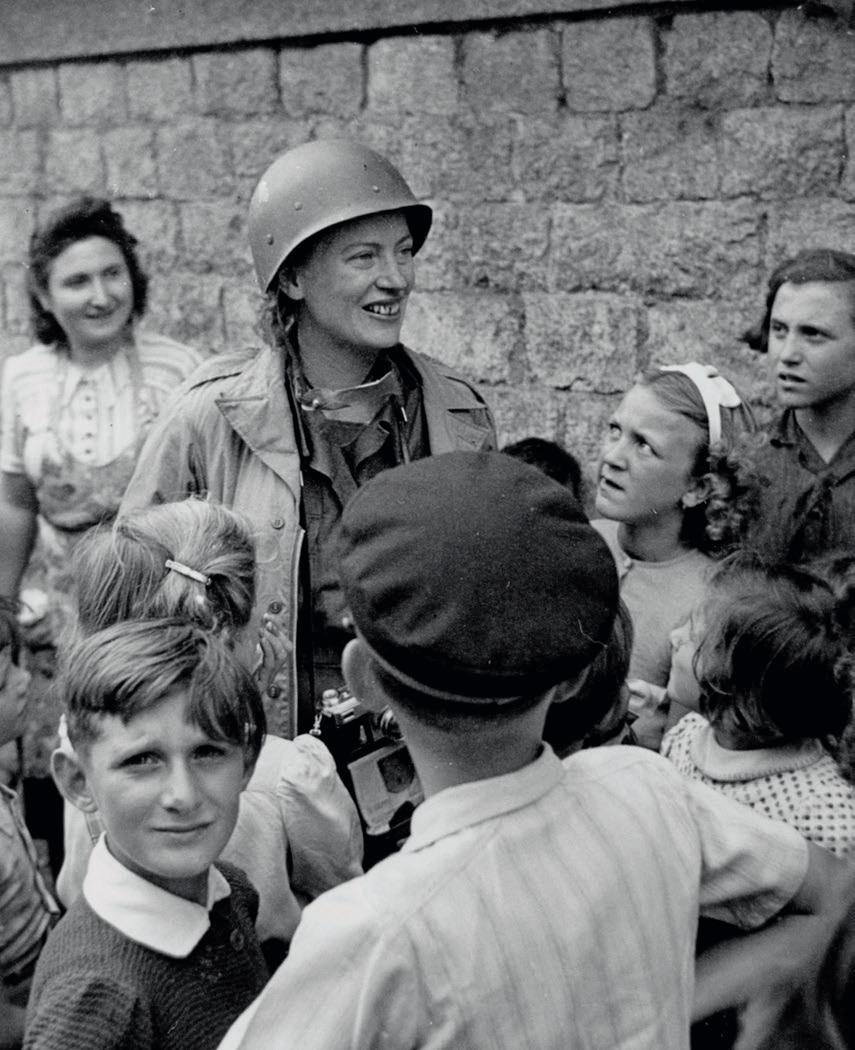
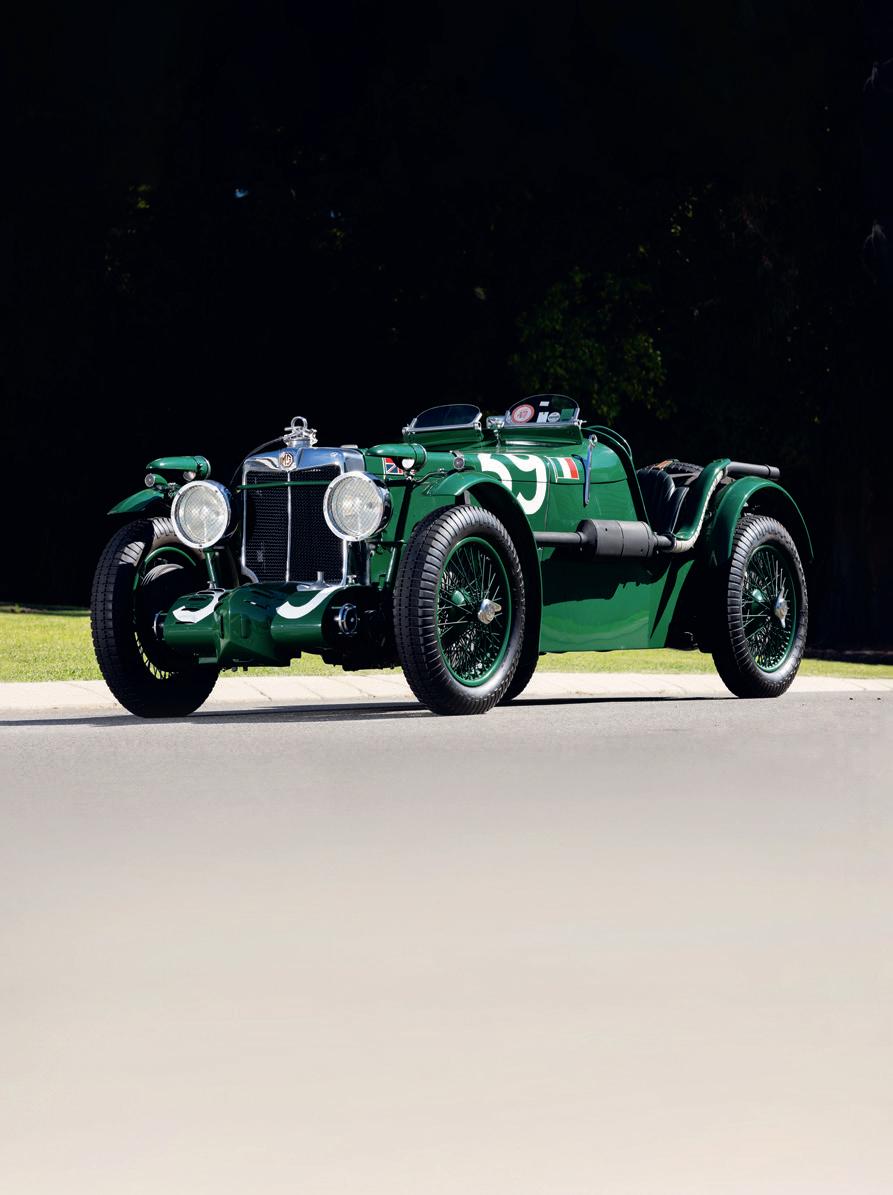
+44 (0) 20 7468 5801 ukcars@bonhamscars.com bonhamscars.com/revival

WORDS BY SOPHY GRIMSHAW
How Goodwood Revive & Thrive champion
Paula Sutton puts her own spin on vintage style
“I’ve never wanted my home to feel like a museum,” says Paula Sutton. “But I also want a beautiful home, with a hint of the past.” There’s more than a hint of the past at Hill House, her Georgian home in Norfolk. Sutton’s knack for sourcing and styling antique, vintage and secondhand finds has seen her steadily build a following for her Hill House Vintage website, while attracting the attention of international media including The New York Times
In her garden, for example, she has adapted vintage lamps and even a chandelier for outdoor use, while chipped China teacups hold birdseed. Her kitchen features a Regency tea urn and walls studded with antique jelly moulds, but the modern appliances aren’t hidden away, either. It’s a similar story in her home gym, where a Peleton Bike sits in a serene, 1950s-style space. It all feels faintly cinematic – and she has the vintage outfits to match.
“I do have some things that aren’t necessarily practical any more but they are just beautiful,” Sutton says. “Items that, to me, serve the same purpose as owning art. I’m never going to make tea in that urn but it’s the most beautiful piece, almost like sculpture.”
A born and bred Londoner, Sutton’s previous “high-octane life” included stints in fashion PR and senior media roles such as head of press for Elite Premier model agency. But as the then parents of “three under three”, with twin girls and a son, she and her husband Duncan made the decision to move out of the capital in 2010.
Sutton has created her own take on an English country house aesthetic at Hill House ever since, enriched with influences from her Caribbean heritage, which is where she feels her “love of bright colours” comes from. “Sustainability is all about making vintage work for our lifestyle and our life now,” says Sutton. “It’s ‘vintage style, not vintage values’, as they say at Goodwood Revival. As a Black woman, if I was living back in the same days as my favourite era of dressing up, I wouldn’t have the freedoms I have now. So it’s not about pretending to be from a different time, it’s about making sure we utilise the wonderful things that we have from the past.”
Paula Sutton is attending Goodwood Revival, 6-8 September 2024, as a Revive & Thrive champion. Her website is hillhousevintage.com
WORDS BY ALEXANDRA HARRIS
A new book explores the remarkable work of the Smith brothers of Chichester, who painted their local landscapes as a rural idyll
In the 1760s, when British landscape painting was an uncertain new phenomenon, three brothers became known as “the English Claudes”. Their glowing pictures showed scenes reminiscent of southern England, and yet this was an England transfigured. It lay dreaming in the warm gold of Mediterranean dawns and dusks. It was an imagined country inspired by the paintings of Claude Lorrain. It was a vision of Arcadia created by a Sussex family: the Smith brothers of Chichester.
I grew fascinated by these artists as I worked on my book The Rising Down. I was tracing unexpected lives in Sussex over many centuries, trying to work out how different people have looked at this patch of our earth. The Smiths looked at it as local people, tenderly painting the rivers and downland they had known since childhood. But they were European painters too, in love with the “ideal forms” of Lorrain and Poussin, eager to show that comparable beauty could be found close to home.
William, George and John came from a family of Chichester coopers. As boys they helped in the workshops where the kegs and barrels of a busy port town were made. It’s not clear how William’s drawings came to the attention of Charles Lennox, the 2nd Duke of Richmond, but the result was funding for training as an artist in London. William then taught George, who taught John.
With reputations established and prizes won (“First Premium” three years running at the Society of Arts), the brothers returned to Chichester, working in a shared studio. While William focused on still-life, George and John dedicated themselves to landscape. They signed themselves “of Chichester”. There was independent-minded radicalism in this. They knew culture could thrive outside London.
From rooms on North Street, near Chichester’s Market Cross, the Smiths sent their “picturesque prospects” out into the world. The most ambitious paintings, though, were reserved for their patron, the 3rd Duke of Richmond, who continued the support offered by his father. That’s why today, in the Ballroom at Goodwood House, you’ll find two magnificent landscapes that take your eye soaring through miles of country. One is by George, the other by John – those “ingenious artists of Chichester”. The Rising Down: Lives in a Sussex Landscape by Alexandra Harris is published by Faber (£25)































Tales worth telling, from the future of vintage fashion to the high-octane life of motorsport pioneer Betty Haig. Plus: e Goodwood Interview with Dita Von Teese
“I’ve never been an exhibitionist, I just love the glamour and the art of creation”


Ahead of Dita Von Teese’s eagerly anticipated appearance at Goodwood Revival, we meet the burlesque performer who has reinvented the art form for a new audience

Like most of us, Dita Von Teese occasionally drives to the supermarket to pick up some groceries. But when she emerges from her local 7-Eleven in her hometown of Los Angeles, she o en finds a man gazing incredulously at her parked car.
A er all, Von Teese, 51, believes in doing everything as stylishly as possible, so she has usually made the trip in one of the classic cars in her collection – possibly her 1940s LaSalle convertible or her 1953 Cadillac Fleetwood (she also owns a 1952 Mercury “lead sled” and a 1977 Excalibur, and is currently restoring a 1952 Woodill Wildfire).
“ e guy will look at me and be like, ‘Are you driving this yourself?’” she says, with a so laugh. “I’m like: ‘I’ve been driving three-on-a-tree [using an old-fashioned manual gearstick] since I was 22 years old. I can drive any vintage car you put in front of me.’”
No wonder Von Teese, the world’s most famous burlesque performer, who has entranced audiences for decades with her evocation of more glamorous times, is excited to be making her first visit to Goodwood in September for Revival, where the unique blend of vintage fashion and classic cars corresponds with two of the biggest passions in her life.
“I’ve never been before, but I’ve seen photos – I’ve been a vintage car collector since I was 20, starting with my first car, which was a big 1930s Chrysler New Yorker,” she says. “I had a 1965 Jaguar S-type at one point – it was beautiful. I bought it on eBay late one night while I was drinking wine. I remember waking up, thinking: ‘Did I buy a car on eBay last night?’ Its brakes used to go all the time – one time when I was driving up the winding hill to the Playboy mansion. I saw all the valets in their red coats and had my head out of the window, shouting, ‘No brakes!’ A er that I was like, ‘I can’t do this any more.’”
A leading proponent of vintage fashion, Von Teese will be judging the Goodwood Revival best-dressed competition (she will also be in conversation with Dandy Wellington on the Revive & rive stage). At an event known for its attendees’ unusually dedicated attention to historically accurate detail, it will be exactly her sort of challenge. “I’ve done TV shows, judging things, but never anything like this. It’ll be hard to choose favourites, I’m sure.”
And what will she be wearing to Revival? “I have a vintage suit in mind that I bought back in the 1990s – I think I was smart to pick it out when I was only 20 years old,” she says. “ ere was a point where, when I drove my 1939 car, I made sure that everything [I wore], from head to toe, was exactly correct for that time. So I would choose perfect period clothing and was very knowledgeable about that. But as the years pass, I love to mix the eras, the old and the new. But I don’t wear vintage shoes any more because I can’t tell you how many pairs of beautiful 1930s shoes I’ve ruined, swing-dancing.”
Friendly and voluble, quite unlike the mysterious vamp she portrays on stage, Von Teese is telling me all this over Zoom from her hotel in Las Vegas, where she’s been living for eight months during her Dita Las Vegas residency at the Horseshoe hotel. Home, however, is a 1920s Tudor revival house in the Hollywood Hills, which – naturally – is packed with all manner of secondhand finds, including a great deal of taxidermy, such






O cial retailer of the world’s most desirable cars and Britain’s leading luxury motor group










“ People need examples of women being beautiful and sensual in all stages of life”

as a stu ed tiger in her living room. “I also have two white swans, getting into the mate position, that I also bought on eBay,” she says.
e house features a room for her shoe and hat collections – mainly from the 1930s and 1940s. Another room contains a huge island packed with drawers for sunglasses, gloves, belts and berets. en there’s a hair and makeup area, where Von Teese styles her blue-black 1940s chignon (she’s naturally blonde) and applies her trademark red lipstick. Both are in evidence as she speaks to me now. She’s wearing cat-eye glasses from her own collection and a contemporary colourful ca an from Filipa de Abreu. For Von Teese, this look is about as casual as it comes. “Even going to a Pilates class, I wear a nice, fitted t-shirt, ballet flats, my Capri pants. I’ll put a coat over it, so it looks glamorous, and always the red lipstick and sunglasses. It looks put together, but I can wake up literally 15 minutes before I need to leave the house and get out,” she a rms. is passion for glamour was inculcated in Heather Renée Sweet, the name on her birth certificate (old friends and family still call her Heather), when she was growing up in Rochester, a tiny town – “with just one stop light” – in Michigan. e middle of three daughters, she loved watching movies from Hollywood’s golden age with her mother, a manicurist (her father was a machinist at a company that made graphite). “I’ve never been an exhibitionist,” she says. “I’ve just always loved dance, and I love the glamour and the art of creation. Burlesque was where I looked for that.”
When she was a teenager, the family moved to Orange County, California, where Von Teese found herself unable to a ord designer jeans like her wealthier classmates. Instead, she trawled thri shops for outfits and supported herself by working in a lingerie shop, both of which helped develop her unique style. She enjoyed ballet as a teenager, but had no career focus, so a er leaving school she dri ed into working as a go-go dancer in the burgeoning rave scene, dressing up in Jean Paul Gaultier-style pointy bras and corsets. A er a visit to a burlesque club, she realised she could earn much better money by joining their dancers. “I had stockings up to my thighs, black leather opera gloves. I was still showing very little skin.”
It’s that appreciation of retro beauty that means – as Von Teese is at pains to explain to some critics – the vast majority of her audience has always been female: there to enjoy the spectacle rather than be titillated. She has performed all over the world, including Paris’s legendary Crazy Horse cabaret. Her extensive knowledge of all things vintage has fed into routines such as Lazy, based on Marilyn Monroe’s performance in ere’s No Business Like Show Business, and e Black Swan, inspired by Swan Lake Props have included a carousel horse, a giant powder compact and a clawfoot bathtub with a working shower head.
Most famous, perhaps, is her martini glass dance, where Von Teese bathes in a giant cocktail glass, dousing herself with a sponge that looks

like an olive. It featured in the 2022 video for Taylor Swi ’s Bejeweled, with Von Teese playing a fairy godmother to the singer’s Cinderella and teaching her the routine, which both performed in parallel. “[Swi ’s team] let me lead the styling of it all, down to her wearing the same kind of shoes and stockings as me, so it was really fun to bring her into my world and have her be so receptive to it and want everything to be just right,” she says. “Now there are a lot of new, young fans learning about burlesque for the first time. I went to her LA [Eras tour] show and there were girls dressed up in really cute little outfits that looked like a martini glass with little olive sponges. It was really fun to see.”
Over the years Von Teese has encountered all kinds of big names in entertainment, but only a handful have intimidated her, including Prince, Elizabeth Taylor, Lauren Bacall and Madonna. “Anybody who knows Madonna knows what I’m talking about,” she says. “She’s so razorsharp.” She was also overwhelmed when she met the then Prince Charles at Cartier International Polo in 2008. “All your tabloids had headlines like ‘ e Prince and e Show Girl!’” she exclaims. “It was one of those moments where I was like, ‘I can’t believe this is happening!’ I grew up a 1980s kid, thinking I was going to marry Prince Charles, watching the Royal Wedding on television.” Even more thrillingly, the late Queen then walked past. “It took my breath away. She had pale skin and rosy cheeks and pink lipstick and the perfect hat. I’ve never been so in awe in my life.”
Plainly, despite her outré image, Von Teese is something of a traditionalist at heart. Her marriage to musician Marilyn Manson in 2005 only lasted a year, and she subsequently declared that the relationship ended because of his “infidelity and drug abuse”. She’s been in a relationship with graphic designer Adam Rajcevich for the past decade, but graciously declines to discuss it. “I’ve dated a slew of well-known actors and singers – a lot of people don’t even know about some of the men I’ve dated. I just like to keep my personal life on the down-low.”
She says that she grew up expecting to become a mother, but it never happened. “Time just flew by,” she shrugs. “I’ve been on this trajectory since I was 19 and I was so surprised at having a career like this, and grateful for the opportunity to do something out there, that I just kept going, thinking, ‘I’ve got to roll with the punches.’ Eventually at one point I was like, [having children] is not the most important thing I’ll ever do. is is my path and I’m having a great time.”
At some point, Von Teese says, she’d like to retire to an old house in the country with a gaggle of animals (over the years she’s had various dachshunds and several generations of Devon Rex cats). ere, she’ll finally let her hair dye grow out. “I hope I’ll be a silver fox like my father.”
For now, she’s still too busy with her career, which – contrary to all of her and society’s expectations – continues to flourish. “People have
“[Meeting Prince Charles] I was thinking, ‘I can’t believe this is happening!’”

been asking me for 25 years: ‘What will you do when you can’t do this any more?’” she says. Yet not only is Von Teese still in excellent physical shape, thanks to a combination of regular Pilates and weight-training, she’s also now making it her mission to convey a message about older women in her performances, which she says have always been aimed at resonating with as wide an audience as possible. Her shows that feature other performers have for some time included a variety of types of body size, sexuality and skin colour.
“My shows have always stood for diversity and inclusion and that includes age. People need examples of women being beautiful and sensual and living in their erotic power in all stages of life, because we don’t see that very o en.” She’s been inspired by women like Jennifer Lopez and Gwen Stefani refusing to be cowed in middle age. “So now I need to be prepared to be the example for other people – or else what am I doing?”
Dita Von Teese will be appearing on the Revive & rive Stage at Goodwood Revival as a guest judge in the Best Dressed Competition on Friday 6 September 2024. She will also be in conversation with Dandy Wellington on Sunday 8 September

Launched 60 years ago, the Meyers Manx dune buggy was pure sunshine in a car, and it swiftly attracted a roster of highprofile admirers that included the actor Steve McQueen. Now, as this Californian classic is reborn as an all-electric vehicle, Alex Moore salutes the freewheeling genius of its original creator, Bruce F Meyers



Bruce F Meyers once described the Meyers Manx, the iconic dune buggy he single-handedly designed and built in his Newport Beach garage, as a reflection of his lifestyle, “which is all about being free”. e car was the automotive embodiment of Meyers’ freewheeling existence, but it also captured the countercultural zeitgeist of 1960s California. Upon the news of his death in 2021, a New York Times obituary credited Meyers with having “revolutionised o -road riding”, while a tribute from the California Surf Museum noted that “If you took everything that is pure Southern California [...] and poured it all into a huge cultural Cuisinart [mixer], out would come Bruce Meyers, driving a Manx.”
2024 marks 60 years since Meyers unveiled the world’s first street-legal dune buggy, a vehicle he brought into being expressly to get himself and his beach-bum friends to the best, most remote, surf spots. Inspired, he once said, by “the little dinky cars with big fat tyres” driven by Donald Duck and Mickey Mouse, the Manx – like so many sand-faring vehicles of the time – was built using the shortened chassis of a Volkswagen Beetle. However, Meyers, a boat builder by trade, believed he could improve on the existing Mad Max-esque hack jobs by attaching a reinforced fibreglass monocoque much like the hull of a boat, with complex curves helping to provide both structural sti ness and a unique, endearing appearance. It had space for a couple of sur oards and half a dozen beers – or, as Meyers put it, the essentials.
With Old Red, as Meyers a ectionately named the prototype buggy, he was sure he was onto something – so much so that he promptly knocked up another 11 fibreglass monocoques and began selling it as a kit car. Business was slow, to begin with, but Meyers, ever the polymath, had a marketing masterstroke up his sleeve. To demonstrate the Manx’s capabilities, he and a friend raced 1,000 miles o -road from Tijuana to La Paz in Old Red. ey beat the previous record – set by American stuntman Bud Ekins on a
Honda motorcycle – by five hours, and conveniently had two journalists from Road & Track magazine witness the whole thing. e subsequent press release, entitled Buggy Beats Bike in Baja made an impression with the major news outlets. Orders flew in and Meyers and Old Red became household names overnight.
“He created a brand-new segment,” says Freeman omas, the automotive designer behind Volkswagen’s New Beetle and the Audi TT, who, since 2020, has been the CEO of Meyers Manx. “It wasn’t just a dune buggy, it was this thing that was a sports car; it was o -road; it was a Baja winner; it was a movie star; it was a design icon; it was all of those things. And like the original Levi’s jeans or a plain white t-shirt, it transcended social classes.”
omas, who says Meyers was always one of his design heroes, came on board when the company was bought in 2020 by “petrolhead venture capitalist” Phillip Sarofim, CEO of “planet-positive” investment firm Trousdale Ventures. With the blessing of Meyers and his wife Winnie, the pair are giving the marque a “rebirth”, front and centre of which will be the all-electric Manx 2.0, launched to coincide with the brand’s 60th anniversary. “What we’re doing is a continuation of Bruce’s story,” explains omas, who sees his role as that of a “cultural architect” rather than simply a car designer. “It’s a global story with a California slant. It’s that part of California that we love, the spontaneity and dreaminess – everything Bruce was able to inject into the brand’s DNA. He was a funloving, charismatic person who was able to get people to love what he was doing.”
Opposite: the all-electric Manx 2.0.
Above: Bruce F Meyers poses with a selection of buggy outer shells

“Like the original Levi’s jeans or a plain white t-shirt, [the Meyers Manx] transcended social classes”
e actor and amateur racing driver Steve McQueen was one of the Manx’s more high-profile admirers. In 1968, he and Faye Dunaway raced around the dunes of Crane Beach, Massachusetts in a one-o Manx that McQueen had helped modi , for scenes in e omas Crown A air. e script had originally called for a Jeep, but McQueen insisted on a Manx a er seeing one flying through the air on the cover of a 1966 issue of Hot Rod magazine. In an interview at the time, McQueen said, “Crown lives at the beach, and he has a sand dune buggy. I helped ’em design it, so I’m kinda proud of that. It’s set on a Volkswagen chassis, with big ol’ wide weenies, big wide tyres on mag wheels, Corvair engine stu ed in the back… It’s very light, you know. It’s pulling about 230 horses, and the vehicle weighs about 1,000 pounds.” ( at same year, Elvis Presley would bash the dunes of Malibu in a Manx for the opening scene of Live a Little, Love a Little.) McQueen’s Manx sold at Bonhams’ Amelia Island Auction in 2020 for $456,000, making it the most expensive beach buggy ever sold. at same blood-orange Manx will be joined by another 99 dune buggies at Goodwood Revival – as part of a parade opening the track each day – to celebrate the brand’s 60th anniversary. “Going forward, we’ve decided we’re going to embrace all dune buggies inspired by Bruce’s design,” says Richard Gauntlett, the son of former Aston Martin CEO
Victor Gauntlett, and now Brand Director at Meyers Manx. “Wherever you go in the world, you’ll find buggy people getting together and doing buggy things – there’s a huge community side to it.”
Meyers only produced around 7,000 of the original Manx model, but by 1969 there were at least 70 companies knocking o his design. Despite Meyers holding a patent, there are now estimated to be around 300,000 “Manx clones” around the world – its iconic appearance and the relative ease with which it could be reproduced making the Manx the most copied vehicle in history. e Californian took it all in his stride, but the competition from copycats would prove too much, and he closed the business in 1971, before going on to invent a fibreglass hot tub. Reflecting on the brand’s untimely closure, in 2012 he said, “ e Japanese have a saying: ‘In all things can be found something beautiful.’ People smile when they see the Manx. Don’t focus on anything but those two people driving it, who are happy. I’ve seen thousands of dune buggies. If you think about the happiness that I brought to those people, then that’s a good thing.”
For the Manx 2.0, omas has channelled the same “whimsical flavour” that can be found in the designs of both Meyers and Erwin Komenda, another great influence who designed Porsche’s Type 60, 356 and 550 Spyder. “Everything

“It’s that part of California that we love, the spontaneity and dreaminess”





those guys drew just made you smile,” says omas. “I’ve always said that the Meyers Manx was the love child of Porsche and Volkswagen, but born in California, right?”
ere’s a rather neat circularity to the fact that Ferdinand Piëch, grandson of Ferdinand Porsche, the brains behind the Volkswagen Beetle, brought the first Meyers Manx to Europe in 1965. According to Piëch’s nephew, Mark Porsche, he bought two kits directly from Meyers during a race at Laguna Seca in California. In 2021, Mark managed to track down and buy one of those cars. In the process he also ended up purchasing two more Meyers Manx dune buggies. One of these turned out to be the Manx driven by the actor Chuck Connors in a short-lived TV show called Cowboy in Africa It was restored around a decade ago and now has, as Porsche describes it, an “Evel Knievel paint-job – all red, white and blue”. It was perhaps that daring colour scheme that helped the car win Best in Class at Poltu Quatu Classic in Sardinia in 2022. “We’ve made so many amazing memories with that car,” says Porsche, “not least beating a number of Fiat beach cars owned by the Agnelli family” before “cruising down the Costa Smeralda in it”. As if to demonstrate the car’s versatility, the following year he took it to his cousin’s event, FAT Ice Race in Zell am See, where it once again stole the show. “I think in Europe the buggy’s appeal is this idea of Americana,” adds
the Austrian. “But for me, personally, it’s the combination of a California-style exotic car, but one that’s built on my greatgrandfather’s Volkswagen.”
Mark Porsche’s three Manx dune buggies, each of which has been fitted with a Porsche sport engine, will also take part in the parade at Goodwood Revival. He says they have around 100 hp, but that still won’t make them the quickest buggies on the grid. Indeed, the 40-kWh Manx 2.0 can generate 202 hp, taking it from 0-60 in 4.5 seconds, despite being almost 200 kilogrammes heavier than the original. Yet while the Manx made its name as a high-performance racer, and its speed and handling will always seduce, at its core Meyers’ brainchild was more about a lifestyle, about spirited adventure with the wind in your hair. For as Gauntlett points out, merely being in a Manx’s orbit is usually enough to get the dopamine pumping. “I’ve never driven a car that causes so many people to stop, smile and wave,” he grins. “When you’re in a Manx, you do really a ect your surroundings. I mean, you’re radiating and receiving endless good vibes.” at is a legacy that Meyers, first and foremost a So Cal surfer, would surely be stoked about.
e 2024 Goodwood Revival Track Opening Parade on 6-8 September features a special contingent of Meyers Manx and pre-1966 beach buggies

















At Goodwood’s first ever Future of Vintage Summit, leading experts from across the UK’s pre-loved fashion market came together to share insights – from the challenge of AI to a new generation’s passion for the past. Sarah Bailey reports on the changing landscape of vintage style

Antique clothing aficionado Virginia Bates is resplendent in a 1920s embroidered opera coat, while Hill House Vintage founder Paula Sutton sports a nipped-in 1940s skirt suit, sourced on Etsy. It’s a creatively and sustainably dressed delegation that is gathered at the inaugural Future of Vintage Summit at Goodwood House in spring 2024. e panel of experts includes stylists, broadcasters and purveyors of vintage clothing, for a conversation chaired by journalist and sustainable fashion consultant Anne-Marie Curtis. All have been invited here by e Duke of Richmond and Gordon.
“What we can do at Goodwood – and what we have done for many, many years – is help to convene experts and bring people together,” e Duke explains. “ e task today is to explore and future-proof the vintage fashion o ering at Goodwood Revival and beyond. “We want to understand the market that we’re engaging with and how we might better support it, in the face of the various challenges posed by today’s volatile retail climate.”
As any fan of authentic period clothing will know, September’s annual Goodwood Revival o ers curated vintage fashion stalls alongside the
motor racing – a much-loved feature of the festivities that has grown in size and importance over the years. It’s a cultural and shopping opportunity that befits an event with an optional period dress code from the 1940s to the 1960s, one that is enthusiastically adhered to by Revival drivers and spectators alike. e Duke sees an opportunity to elevate this vintage fashion gathering still further, transforming it into the preeminent destination for pre-loved fashion globally; a prestigious environment for top-tier traders to present rare pieces while providing exceptional customer service and reassurance for new and seasoned collectors.
e world of secondhand fashion is rapidly changing. With a plethora of online resale platforms, a generational shi in attitudes to pre-loved fashion and a growing awareness of environmental circularity, the idea of “vintage” has now entered the mainstream. At the same time, the advent of artificial intelligence and other new tech could see diminishing demand for rare vintage clothing in film and TV production, threatening specialist traders’ livelihoods. ese and other challenges shaped the discussions on the day. Read on for some key takeaways.
“I just wanted to be different. My mother wore roll-on corsets and big skirts, but I had no interest in that”


Chair Anne-Marie Curtis begins by throwing down the gauntlet: “What do we classi as ‘vintage’?” Goodwood Revival attendees are invited to dress in 1940s, ’50s and ’60s fashions, of course, but where should the definition of “vintage” begin? e Y2K craze among younger fashion customers on social media begs the question of whether something that was manufactured and sold in the Noughties should now be classified as vintage.
“Our speciality is quality pieces that come from the 1980s up to the early 2000s,” says Henry McNeill-Njoku. He and his university friend eo El-Kattan (who’s also here today) co-founded Known Source, a retail platform which supports small, independent, secondhand sellers. “We tend to use the word ‘secondhand’ over vintage because we focus on pieces that have been in circulation more than once.”
“I used to hate the word ‘vintage’; I’ve always used ‘antique’,” says Virginia Bates, a former actor who founded her own West London boutique more than 40 years ago. Rachel Reavley, strategic advisor at luxury resale platform Hardly Ever Worn It, says her audience feel more comfortable with the term “pre-loved”, which avoids the connotations of “old” garments that had been “worn out”. Whatever you call it, the nomenclature discussion reveals that vintage clothing appeals to multiple fashion audiences, and successful sellers speak to their customers in language that resonates.
“How should we define rarity?” is is the question asked by Herbie Mensah, a former Vivienne Westwood model turned designer and trader, whose one-o upcycled pieces make his stall at Friday’s Portobello Market a stand-out. A 1960s Chanel couture jacket may be hard to come by, and is therefore a rare find, but Mensah’s Gen-Z daughter also has a penchant for vintage T-shirts, for example. “What is a rare piece? A limited edition of eight or ten?” he wonders.
McNeill-Njoku points out that streetwear pieces might have a unique origin story that adds to their mystique and rarity: “What I love about secondhand fashion is that each garment has its own lineage in terms of who has previously owned it. And that can add to the rarity of it, and that isn’t appreciated a lot of the time.”
“I just wanted to be di erent,” says Virginia Bates of developing her own personal style as an actress in the 1950s and ’60s. “My mother wore roll-on corsets and big skirts, but I had no interest in that. I wanted to wear these Victorian things that I was finding.” ough she no longer trades out of her eponymous shop in Holland Park, where designers from John Galliano to Erdem came to research their collections, Bates still likes to sell in person and runs a weekly stall, which allows her to talk through a piece and encourage a customer to cra a memorable look for a special event, safe in the knowledge that no one else will be wearing the same thing.
“How should we define rarity? A limited edition of eight or ten?”
Rachel Reavley reflects on the growth of the pre-owned luxury market, talking with the group about how to “tilt” consumer mindsets towards vintage. is already chimes with “the normalisation of the sharing economy”, she points out. “People take Ubers and stay in Airbnb properties, so why on earth would they have any reticence about something that happens to be pre-owned or pre-loved?”
Presenter Scott Wimsett agrees, adding that the younger generation has a fresh approach to pre-loved fashion and circularity. “With some of the kids I know, there’s zero tolerance towards buying new. ey’re exploring pre-loved, vintage, secondhand, charity, thri ing – and it’s not defined by wearing certain eras. ey mix everything up and become their own stylists.”
“I think it’s really important in the debate surrounding vintage that we don’t ‘tell people o ’,” says Paula Sutton of Hill House Vintage. “I think we should allow people the grace to be ‘vintage fluid’. at way you’re going to encourage more people to get involved. ere can be a tendency for people to think, ‘I can only be vintage, if I’m into vintage.’ I think you should allow people to pick, choose and be creative.”


The shape of beauty.
Ferrari invite you to discover the Ferrari Roma Spider. A timelessly elegant high-performance car, encapsulating a contemporary take on the chic, pleasure-seeking Italian lifestyle of the 1950s and 60s.
Contact your Of cial Ferrari Dealer to discover more.
Fuel economy and CO2 results for the Ferrari Roma Spider in mpg (l/100km) combined: 14.7 (19.2) – 29.7 (9.5). CO2 emissions: 437 – 217 g/km. Figures shown are for comparability purposes; only compare fuel consumption and CO2 gures with other cars tested to the same technical procedures. These gures may not re ect real life driving results, which will depend upon a number of factors including the accessories tted (post-registration), variations in weather, driving styles and vehicle load.
e impact of AI in film and TV costume departments is already being negatively felt by vintage traders. e group discusses the fact that now sometimes only the principals in a film are dressed in period costumes, while extras have their costumes “painted” digitally in post-production. However, there is acknowledgement among the group of the positive role that technology could play in the luxury vintage marketplace – for instance, in the fight against counterfeits, or the documentation of provenance. “Blockchain” technology can also allow for individual items of clothing to be tagged with digital labels, to veri a piece’s origin and ownership every time it changes hands, points out eo El-Kattan, of Known Source. Nobody around the table is yet taking advantage of blockchain’s capability, but there is definite interest. Watch this space.
e group discusses how changing clothing shopping and storage habits can encourage consumers to feel more confident buying and reselling clothing and accessories. “We educate our audience to keep the dust bag, keep the receipt, store your piece in such a way that in 18 months you can resell and get back 68 per cent – or more – of what you paid for it,” says Rachel Reavley.
ose who are selling the clothing can be making changes, too. “Needlework should be brought back!” says Virginia Bates. “As a trader, you should always have a tailor on site.” e takeaway here is clear: whether you are a buyer or a seller, accessing tailoring and repair services keeps vintage fashion looking its best and in circulation.
“Look at the platform e Seam,” adds presenter Scott Wimsett. “I love that it is highlighting all these amazing makers across the UK, who are really good cra speople and really good at repairing clothing. at feels very progressive, very new-age fashion to me.”
Magazine veteran Kim Hersov is a stylist turned vintage seller, through her curated site e Quaintrelle. When it comes to marketing preloved fashion, she says, “It’s about showing how you wear a piece. Making vintage look sexy is in the styling, how you put a look together.” She makes the case for styling and shooting vintage fashion in editorial and in marketing with the same sensuality and elevated production as you would clothing from the primary market, wherever budgets allow.

“It’s about showing how you wear a piece. Making vintage look sexy is in the styling, how you put a look together”
Our chair, Anne-Marie Curtis, gives the floor to the vintage traders to wrap up the day’s discussions. And there is one topic upon which they all wholeheartedly agree (so much so that they finish each other’s sentences): “It’s the thrill of discovering lost treasure. When I found a closet full of spotless Dior, I nearly cried,” says Mark Baylis. “And then the joy of selling it on!” exclaims Oliver Ross. “To the right person,” adds Virginia Bates. “So that the legacy continues!” concludes Kim Hersov.
It’s abundantly clear to everyone present that the dedication and drive of these expert vintage traders goes far beyond the merely transactional. It’s also very apparent that connoisseurship, curiosity and a lifelong commitment to discovering the beauty and the history of preloved clothing are things that no algorithm can ever hope to replicate.
KIM HERSOV pictured above
e ability to convert a secondhand sceptic to a believer “lies in the power of individuals”, says Curtis, in summary. “It’s in their stories, and in their passion.”



You can’t build a future without respecting the past. It‘s how we‘ve managed our clients’ wealth for 160 years. Managing wealth is our craft .









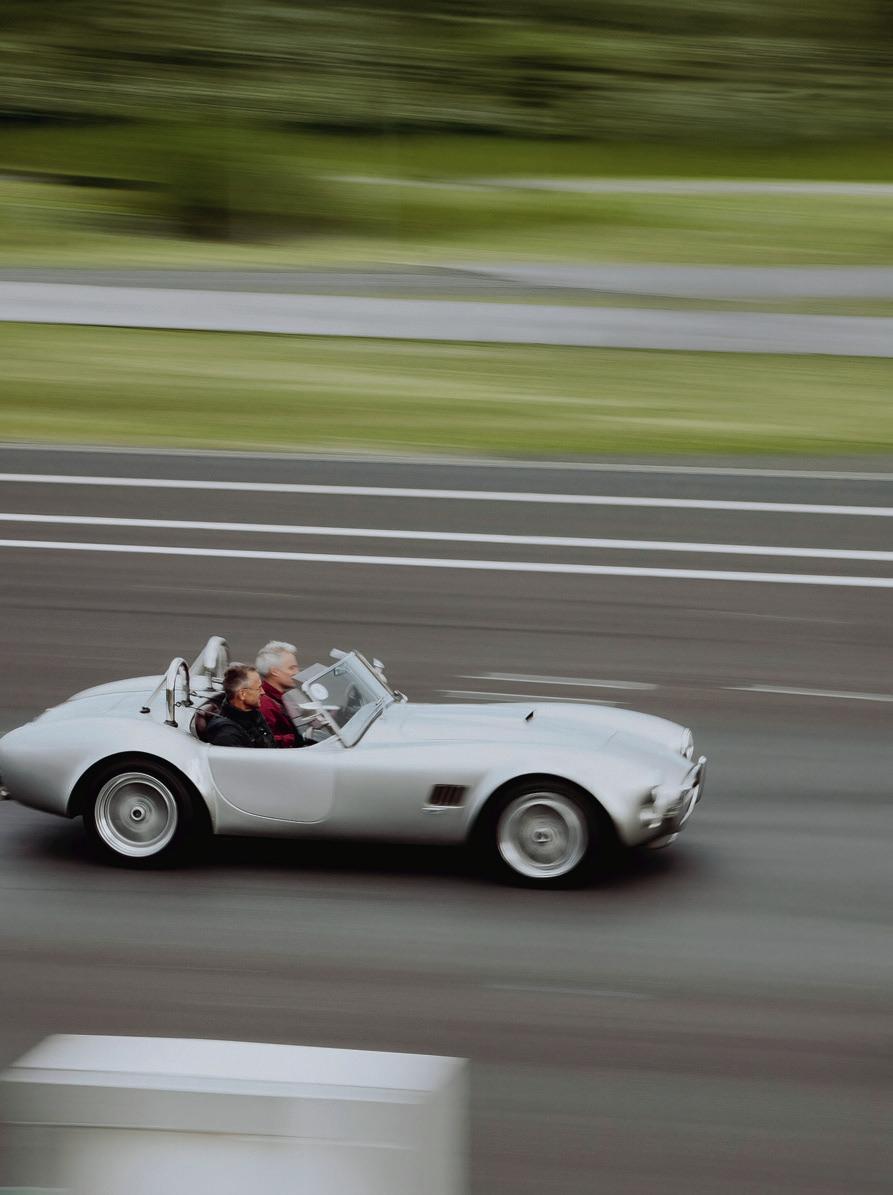


With its airfields, beach defences and strategic location, Sussex was a pivotal centre of operations throughout World War II. James Collard looks back at how the county coped with the tragedy, hardship and prolonged upheaval of those turbulent years
Think of Sussex and we picture flint-walled country lanes and holloways, picturesque villages, the rolling contours of the Downs, and seaside resorts – some, perhaps, a little past their best, but not without charm. Yet for all its bucolic beauty, Sussex’s location meant that this pastoral place would inevitably play a major strategic role in World War II. Its beaches were among those earmarked by the Wehrmacht for a seaborne invasion of England, had the Lu wa e won the Battle of Britain – much of which was fought in the skies above Sussex by fighter pilots operating out of its airfields. Later in the war, Sussex became a vast armed camp as the Allies prepared to liberate Europe, while from its airfields SOE agents were dispatched, supplies for the Resistance delivered and raids launched on Nazi-occupied Europe.
Such vast endeavours were bound to leave their traces. Look closely at these lea landscapes and the marks le by the conflict are plain to see: a concrete pillbox in a quiet river valley; the line of flaking concrete on the shoreline between Pagham and Selsey (the remains of one of the floating Mulberry harbours intended for D-Day); the semi-cylindrical curved roof of a “blister” hangar, repurposed as a barn or chicken run.
More poignantly, there are the names of the county’s dead – etched onto Sussex war memorials, wherever in the world they fell, and on which the repetition of a surname o en signals families who su ered unimaginable multiple losses. en there are memorials to men who died in Sussex, a long way from home. In Boxgrove Priory, a fine stained-glass window honours the memory of Billy Fiske – Olympic bobsledder, Cresta Run champion and socialite – who was fatally injured while flying for the RAF in August 1940, the first American-citizen pilot to die in World War II. A few miles away, in St Andrew’s Churchyard, Tangmere, lies the grave of Hauptmann August Strauch, whose Junkers 88A-1 was shot down during an attack on Farnborough, within a week of Fiske. Unlike Fiske, who landed his stricken Hawker Hurricane, but later succumbed to his injuries, Strauch bailed out, but was found, mortally wounded, hanging from a tree in Worthing. Nearby, an unidentified Lu wa e crew member’s grave is carved simply with the words “Ein Deutscher Soldat”.

Just as men from elsewhere fought in the skies above Sussex, throughout the war the local papers reported news of Sussex men and women serving a long way from home: “Good News A er Two Years Silence: Horsham man is prisoner of Japanese.” “Lt Col JR Kennedy, DSO, OBE killed in action in Libya.” “Haywards Heath man, Able Seaman CA Tampsett, one of 71 saved from sunk liner.” e West Sussex County Council Record O ce in Chichester (which has produced excellent reports on Sussex at war, including its new D-Day West Sussex book) has an index listing many such newspaper reports: epic tales of courage, tragedy, loss and occasionally wrongdoing (such as the butcher jailed for selling Lady Collins more meat than her ration allowed), all summarised in a single line: nurse drowned when her hospital ship was sunk o Java; flight engineer missing a er a raid on Norway; Captain Lionel Queripel of the Royal Sussex Regiment receiving the Victoria Cross, posthumously, for his heroism at Arnhem. e scale of it all is hard to take in. But one overarching theme of Sussex during the war is this sense of lives shi ed and uprooted, changed for ever and, of course, all too o en lost. e stories are moving, but what is more shocking is the series of great human waves, one of which had begun even before war was declared, with the arrival of refugees from Europe. “A Victim of the Gestapo” was the headline in the West Sussex Gazette late in 1939, when, having escaped from Czechoslovakia with his family, Dr Hans Fleischman died of injuries sustained months earlier in a Nazi prison: a life begun in the Austro-Hungarian spa town of Karlsbad ending in Worthing. From that point onwards, those waves kept on coming: child evacuees from the cities; hundreds of thousands of foreign servicemen – Canadians, especially, but also Free French, Czechs and Poles, including many aircrew
who would play a major role in the Battle of Britain. en, as the war progressed, the Americans (including the Allied commander-in-chief Dwight D Eisenhower, better known as “Ike”, who came to Chichester just before D-Day, staying at e Ship Hotel). Finally, as victory approached, the German prisoners of war – sent to work camps near Shoreham and Lancing (where many complained bitterly about the conditions). e end of the war saw the return of Sussex men who had served abroad, or endured years in a Japanese POW camp, along with women and children who had been interned. And well into the late 1940s there were numerous “displaced persons” in Sussex, including hundreds of Poles living in Nissen huts in West Chiltington, who would never enjoy a homecoming – their country was now part of the Eastern Bloc, where Polish and Czech RAF veterans would sometimes be imprisoned as “British spies”.
But of all these human waves, perhaps those child evacuees would have seemed the most pathetic – “forlorn little folk, with their poor little emergency bundles of clothing and gas masks”, reported the West Sussex Gazette. Some 13,000 of them arrived in Chichester alone to be taken in by local families, more or less doubling class sizes overnight. Bognor housewife Mrs Helen Bowes was nominated the nation’s “No 1 Evacuee Auntie” for taking in as many as nine children at a time. e trick, she explained, was to get them all into bed by 7pm. But even with the best of intentions, there must have been some remarkable clashes of culture, as children from Peckham or Whitechapel found themselves suddenly transplanted to rural Lavant or Charlton.
“ e bombers will always get through,” Stanley Baldwin had warned back in 1932, and the prospect of air raids on our cities had been made
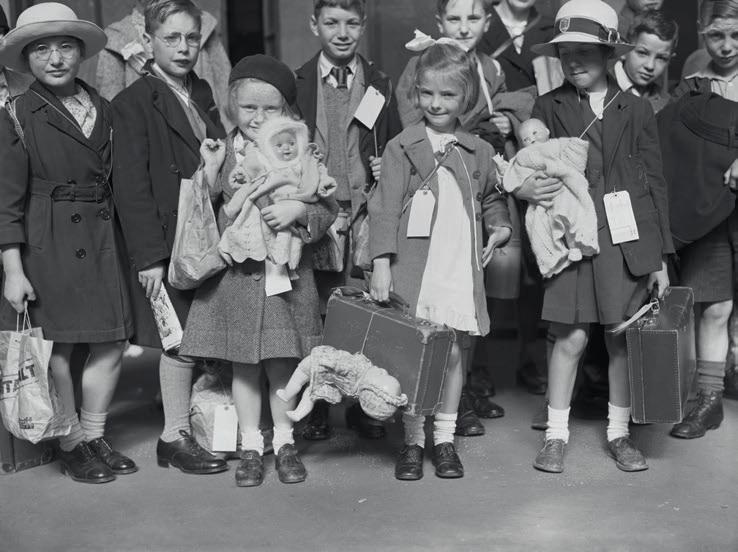
all the more terri ing a er the German and Italian bombing of Guernica during the Spanish Civil War (just concluded, with a fascist victory). And so, on that sunny morning of Sunday 3 September, 1939, almost as soon as Neville Chamberlain had finished saying on the wireless that Britain and Germany were at war, the newly installed sirens sounded and the good people of Sussex braced themselves for an immediate air raid. In Crawley, a policeman cycled along London Road blowing his whistle and urging everyone to stay indoors. When the bombing of our cities didn’t materialise – for many months – some families summoned homesick children back to London. But once the so-called Phoney War gave way to the rapid collapse of Belgium and France in the spring of 1940, the next wave of people to arrive in Sussex would be the soldiers of the British Expeditionary Force, rescued from the beaches at Dunkirk, with many Sussex civilians having sailed their boats over from Chichester Harbour to facilitate their escape.
With the retreating BEF came the realisation that the county’s strategic location – across the Channel from occupied Europe and on the way to London and beyond, both for the Lu wa e and the Wehrmacht – put it very much in the line of fire, and from this point onwards the evacuations tended to be out of Sussex, rather than into it. Roedean School, for example, relocated to the Lake District, while a party of 50 pupils and their teachers
chose instead to go much further, all the way to Canada. One of these girls recorded her long, sometimes exciting, o en frightening journey in her journal. She recalled hearing soldiers just back from Dunkirk singing Roll Out the Barrel as their troop train pulled into Brighton station, just as her own train pulled out of it. And then, having said goodbye to her parents, “not knowing when I should see them again”, she boarded a liner from Liverpool to Quebec, sailing in a convoy that lost a ship to U-boats along the way. “We got up to see the Northern Lights,” she wrote, “but are not sure whether we saw them or not”, which rather suggests they didn’t. At Goodwood, a er much soul-searching, Freddie Gordon Lennox, the 9th Duke of Richmond, and his wife had reluctantly decided to do the same, sending their two sons first to Canada and then on to the USA, where in time they joined the Duke, now in the RAF and attached to the sta at the British Embassy in Washington DC.
Heading in the opposite direction throughout the years of war would be several hundred thousand Canadian servicemen (and later, servicewomen), some being briefly billeted at Roedean, as it happens, before it was repurposed as a Royal Navy torpedo training base (hence an old joke about Roedean being the only girls’ school to have an Old Boys association). And for most of the war, it was Canadian soldiers who manned much of the county’s coastal defences, as from May 1940 onwards Sussex became the first line of defence against a possible German invasion – and a new prime minister, Winston Churchill, roused the nation for years of conflict and what he called “blood, toil, tears and sweat”.
e physical manifestations of this martial spirit were striking and o -putting, which in a sense was what they were meant to be. Beaches

Being a civilian in West Sussex must have involved a mix of the normal and the extraordinary. Life went on, after all
were mined and strewn with defensive devices and barbed wire – to deter amphibious landings. Barrage balloons were floated to keep air raids at bay, while mysterious new radar stations appeared on the cli s overlooking the Channel. Inland, meanwhile, upturned farm wagons were abandoned in flat, wide fields to prevent airborne landings, and those pillboxes were built in “nodal points”, as Sussex’s defenders set about viewing its beguiling landscapes through the eyes of a potential invader, considering purely military factors such as the need for clear lines of fire, rather than a fine view. is steely new approach made for lasting changes: it did for Shoreham’s Bungalow Town, for example, whose arty, bohemian residents were given just 48 hours to pack up before their line of charming, dacha-like seaside homes was demolished on the orders of the military authorities – an Edwardian idyll suddenly deemed a vulnerable weak spot.
Likewise, civilian life changed considerably, as air-raid wardens roved the county’s villages and towns enforcing the “blackout”, policemen and civilians alike kept their eyes peeled for fi h columnists and German parachutists, and young women from the cities arrived to work on farms as Land Girls. Meanwhile, the veterans and youngsters of the Home Guard rallied and prepared to live up to Churchill’s promise to fight them on the beaches and the landing grounds. (And indeed, the much-loved, orepeated 1970s sitcom Dad’s Army was set in the fictional Sussex town of Walmington-on-Sea.)
In the real Sussex seaside towns, as the beaches were o limits to pleasure-seekers, so their hotels and boarding houses filled instead with soldiery – first British and Canadian, then increasingly cosmopolitan, as Sussex evolved from being a line of defence to the launchpad for an Allied
invasion of Europe. By the time George VI inspected the troops in West Sussex in May 1944, not long before D-Day, the park at Petworth contained three military camps. Meanwhile, much of the South Downs had been taken over by the military for training purposes, and the whole county was dotted with airfields and ammunition dumps, with its grand country houses transformed into regimental HQs – or, as was the case with Goodwood House, military hospitals.
e story goes that the Duke had written to the War O ce o ering the House as a hospital, but had heard nothing more – until one a ernoon, while the Duke and Duchess were having tea on the library steps, a large military convoy arrived to set up the hospital. Most of the furniture was swi ly dispatched to the stables, the books in the libraries were boarded up in their shelves, the pictures were all taken down, the tapestries went to the Ice House and all the floors were covered in lino. For the nursing sta though, there must surely have been worse places to be stationed, as once their shi s were done they could explore the Estate or enjoy picnics on the lawn with servicemen stationed nearby.
Meanwhile, the war in the air had to be won – with much of the Battle of Britain fought in the skies above Sussex, flown by pilots based on its many RAF airfields and managed by men and women working out of operations rooms in Chichester or RAF Tangmere. As an airfield, Tangmere predated
part in an attack exercise in Bognor Regis was taken by local photographer Frank

Mastercard is proud to champion women in motorsport, celebrating the heroes of today and inspiring the trailblazers of tomorrow.

Such vast endeavours were bound to leave their traces… and the marks left by the conflict are plain to see
even the RAF, having started out as a Royal Flying Corps airfield in 1917 – when the young Freddie Gordon Lennox, later Freddie March and, in time, the 9th Duke of Richmond, would spend hours watching the planes take o and land. With World War II, RAF Westhampnett was established on the Goodwood Estate as a satellite airfield for Tangmere – which would have a lasting impact on Goodwood, emerging as today’s aerodrome, while the Duke would use its perimeter road as the basis for the Motor Circuit.
“ ings hummed at Tangmere Cottage,” Peter Townsend, a Battle of Britain pilot (and later the lover of Princess Margaret), would recall of life at the station in the run-up to the war, during which time his commanding o cer, John Willoughby de Broke, and his wife, Rachel, “kept open house. ere we spent wild evenings, singing, dancing to romantic tunes… We danced blithely, relentlessly towards catastrophe.”
Later, the cottage would have taken on a much more serious tone, as it was used by the SOE (Special Operations Executive) to hold or receive its agents flown in and out of occupied Europe. At nearby Bignor Manor, Major Anthony Bertram briefed outgoing French agents, with his wife, Barbara, checking their gear for anything that might give the game away, such as British labels in their clothing, and cooking up fine breakfasts with eggs laid by her chickens. SOE operations typically used Westland Lysander planes – which could seemingly land and take o almost anywhere – for flights navigated largely by dead reckoning.
Tangmere played a key role during the Battle of Britain – during which it was bombed by the Lu wa e, killing 10 RAF personnel and three civilians – and then throughout the war. Once again, this was an international e ort, with British flyers joined by squadrons of Free French, Czechoslovaks and Poles, and the Royal Canadian Air Force. And while many of us have grown up with stories of the heroism of Douglas Bader, the ace pilot and veteran of Colditz who flew out of Tangmere, the Poles had their own tales of derring-do. Having fought in the September Campaign against his country’s German and Soviet invaders, Boleslaw Wlasnowolski then escaped from Poland via Lebanon and France, before taking part in the Battle of Britain, during which he was shot down and killed. And among
the many Czech heroes was Karel Kuttelwascher, the RAF’s highest-scoring Czech fighter pilot – who would ultimately survive the war and marry an Englishwoman.
Meanwhile, being a civilian in West Sussex must have involved a mix of the normal and the extraordinary. Life went on, a er all. e sun came out, the birds sang – and a Canadian servicewoman could write home enthusiastically of cycle rides to Bosham and cream teas. But war was also a constant, as can be seen in the images of local photographers George Garland and Frank L’Alouette, which o en capture the strange juxtaposition of military and civilian life: exercises with tanks disturbing the tranquil rural scene; air-raid damage in Littlehampton (on which, astonishingly, almost 3,000 bombs were dropped over the course of the war); the D-Day armada as seen from the beach at Bognor.
Amid all the death and destruction, some particularly grim moments stand out. In September 1942, a lone German bomber aiming for the military camps at Petworth hit a local school, killing 28 schoolboys, the headmaster and a teacher. In July 1943, 108 people died when a bomb hit East Grinstead’s Whitehall Cinema, the largest loss in any single air raid in the county. And alongside the horror, for civilians there were minor upsets and irritations by the thousand – everything from running out of butter to crowded trains, unwelcome lodgers in the form of billeted soldiers, air-raid sirens summoning one from a com bed to a musty Anderson shelter, not to forget the constant thrum of the call to duty and to “do one’s bit”.
Britain had already been at war for almost five long, weary-making years when Flora MacDonald Brown, serving in Queen Alexandra’s Imperial Military Nursing Service (aka the QAs), based at Goodwood House, heard “in the early hours of the 6th [of June] a great deal of noise, and motorcycles

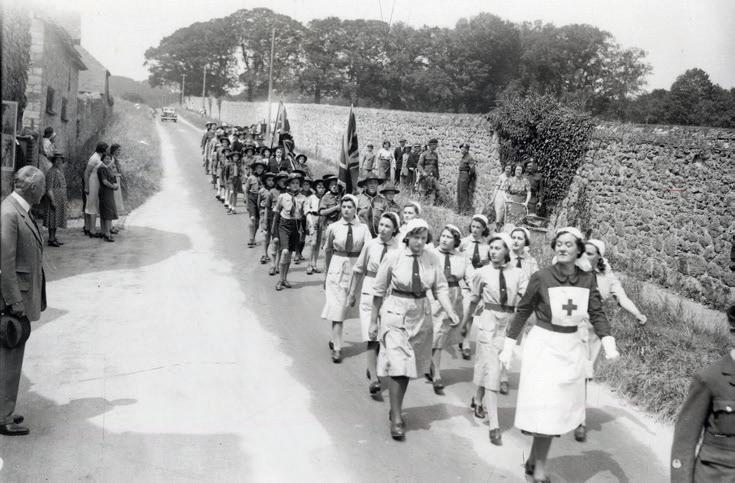
One overarching theme of Sussex during the war is this sense of lives being shifted and uprooted
roaring up and down that lovely drive”. e following day, she and some of her fellow nurses climbed “the green hill set behind the house” to watch the many planes passing overhead. e skies would have been filled with warplanes: Hawker Typhoons harrying the Germans in northern France, Spitfires protecting the troops landing on the beaches themselves. Flora also spotted gliders being towed, “full of young men who were to be cut loose over Normandy and le to dri down to a very uncertain landing”. She had spent weeks folding marquee-like tents; before the month was out, she would be hard at work at a field hospital near Bayeux. By now, the young Gordon Lennox boys were back at Goodwood (having enjoyed a thrilling voyage home, with a party of returning schoolboys, in a British destroyer) and were living in the care of their grandmother, the family enjoying the use of just two rooms upstairs and two downstairs.
e war in Europe would last almost another whole year, the war with Japan even longer – while within weeks of D-Day, war was brought home to the family when Lady Evelyn Gordon Lennox was killed by the German flying bomb that destroyed the Guard’s Chapel in London during a service. (Her husband, Lord Bernard Gordon Lennox, son of the 7th Duke, had died fighting in World War I). But while the fighting continued, perhaps the end was in sight. And with it, there would be yet one more of those great waves of humanity – although this time a much more optimistic one. For when the Canadians stationed in Sussex returned home a er the conflict, departing with them were several thousand local women: war brides, starting a new life, away from the privations of war, in the New World.
is year’s Goodwood Revival, 6-8 September, will pay tribute to the 80th anniversary of the D-Day landings

































A er dancing until dawn, a morning on the farm at Goodwood makes for the most bucolic of a erparties



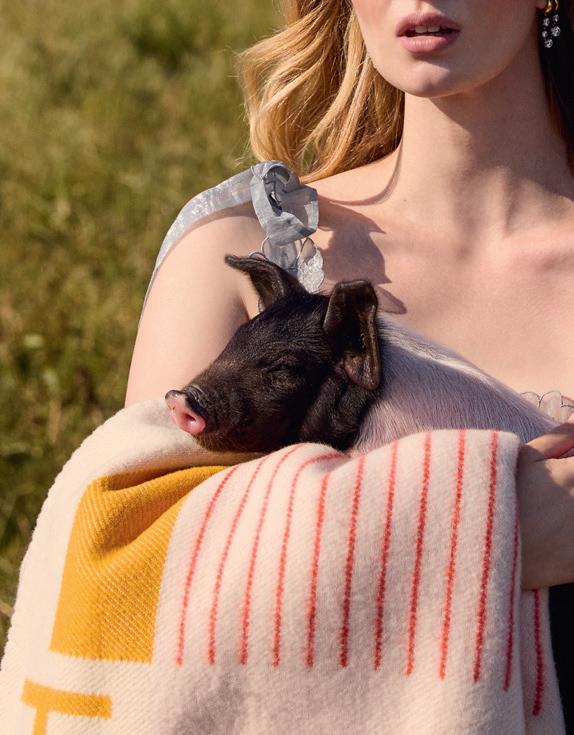





P69: hand-knit silk mohair peach dress with metallic jacquard short jacket, £2,780, by Bora Aksu, boraaksu.com; hand-carved mallard duck-head thumb stick, £495, by Purdey, purdey.com; vintage pearl earrings, POA, by Christian Dior at 4Element, 4element.co.uk; Panthère de Cartier black cowhide belt with gold-finish buckle, £460, by Cartier, cartier.com; Le Chameau La Parisienne boot, £350, from Purdey, as above
P70-71: red silk dress, £1,195, and red polyester sleeves, £795, both by E. Stott, estott.co.uk; Vierzon jersey-lined Wellington boots in chameau green, £160, by Le Chameau, lechameau.com; alpaca socks, £375, by Purdey, purdey.com; 18ct yellow gold and 5ct tourmaline engagement ring, £10,000, and 18ct yellow gold and green tourmaline ring, £8,000, both by Minka Jewels, minkajewels.com
P72: Oswald dress, £2,280, by Cecilie Bahnsen, ceciliebahnsen.com; Solar blackened gold diamond gypset earrings, POA, by Jessica McCormack, jessicamccormack.com; Avalon piano blanket, £1,560, by Hermès, hermes.com
P73: camel Wellbeck poncho, £825, by Purdey; purdey.com; silk Georgette embellished gown, £5,645, by Ralph Lauren Collection, ralphlauren.co.uk; Panthère de Cartier tie pin in palladium-finish sterling silver, black and green lacquer, £1,190, by Cartier, cartier.com
P74-75: Florence (le ) wears 1940s pink silk dress, £248, by Modes & More, modesandmore.com; Carmela gold and diamond spaghettio earrings, £20,000, by Jessica McCormack, jessicamccormack.com; leather hiker boots, £225, by Grenson, grenson.com; cashmere socks, £49, by Brora, broraonline.com ais wears lace gown, £2,950, by Zimmermann, zimmermann.com; black leather boots, £279, by Penelope Chilvers, penelopechilvers.com; black socks, stylist’s own; Signature multi-shape diamond tripset hoops, £15,000, by Jessica McCormack, as above
P76: rose silk gown, £14,995, by Erdem, erdem.com; Signature multi-shape diamond tripset hoops, £15,000, and Cubby daisy diamond ring, £50,000, by Jessica McCormack, jessicamccormack.com
P77: ais (le ) wears silk dress, £3,395, by Huishan Zhang, huishanzhang.com; Wellington boots, £135, by Hunter, hunterboots.co.uk Florence wears sequined gown, £6,000, by Temperley London, temperleylondon.com; vintage velvet evening coat, £240, by Modes & More, modesandmore.com;Wellington boots by Hunter, as above

Winner of countless automotive accolades and one-time owner of more than 60 di erent performance cars, Betty Haig is one of motorsport’s forgotten greats.
Peter Hall recalls the high-octane life of a fearless motoring pioneer
You might never have heard of Betty Haig. Even today, in motorsport, women rarely receive the credit they deserve. Outnumbered from the start, female drivers must overcome so many more obstacles than their male rivals that few break through into the public consciousness before their achievements are once again obscured by the dust of history.
Take Haig, for example. She was a significant figure and ahead of her time, but a 2018 biography, A Life Behind the Wheel, by Roger Farmer, is now out of print, and internet searches reveal only vague and o en contradictory details. Yet in Britain at least, her family name is known, both for its whisky and for its most famous son, Field Marshal Sir Douglas Haig, commander of the British Army during World War I.
Haig was the Field Marshal’s great-niece, and herself the daughter of a soldier, Colonel Oliver Haig. Born in Marylebone, London, on 21 August 1905, she grew up on the family’s Scottish estate, Ramornie, in Fife, until 1920. At that point her mother, Esme, was granted a divorce and moved with Betty and her brother, Peter, to Sutton End in West Sussex.
Both Haig’s parents were car owners and she once enjoyed a ride in the fearsome 21.7-litre Fiat Mephistopheles (the last car to set a Land Speed Record on a public road) but she was initially more interested in horses than anything else. She was already a keen showjumper and hunter when, at 14, she scraped together £12 to buy a war-surplus 2¾ hp Douglas motorcycle as personal transport. Finding that this temperamental beast required more care and attention than any animal, she began to be fascinated by mechanical horsepower, although she was never given an allowance, so money was tight.
A pivotal moment came in 1925 when a great-aunt gave her £60 to purchase a motor car. Refusing anything sensible, Haig found a nippy but worn-out 1922 ABC light car whose fuel tank sat directly above the air-cooled engine. When it finally burned to the ground – too fiercely to be extinguished by the cushion she always carried for that purpose but fortuitously en route to a junior ball at Cowdray Park that she had no enthusiasm for – she sold the story of this mishap for £10 to several newspapers and spent the proceeds on an Austin 7 Sports.
Haig’s unquenchable thirst for speed was now evident. at same year she did a lap of the Brooklands circuit in a Talbot 8 belonging to her boyfriend, Naval Lieutenant Denis Sprague, and attended the very first British Grand Prix, also at Brooklands, in 1926. In 1928 she went so far as to marry Sprague – without informing her family – but it proved to be a poor match; they were divorced a er only four years and for some of that time Haig lived with friends in South Africa.
Betty’s car-buying habit continued unabated on her return to England –indeed, she would own at least 60 vehicles in her lifetime, not all of them in good condition. A brush with the law while driving an unsilenced MG was perhaps the least dramatic of her adventures, which included hair-raising brake failure on London’s Hammersmith Bridge, catastrophic engine seizures and worse. She and her flatmate Joyce Lambert purchased a pair of 600cc Raleigh motorcycles on which they toured Europe. ey also drove to Italy in a Morgan three-wheeler, which had to be towed into Turin behind a racing motorcycle. As Haig later recalled, “You should see the e ect of two girls in a red Morgan in that city.” Inevitably, Haig’s motoring life wasn’t all fun and games. Another Morgan came to a particularly tragic end when she ran into a stationary car on the Kingston bypass, killing her friend Molly Watkins in the passenger seat. Nevertheless, undeterred by the dangers of 1930s motoring – especially in secondhand vehicles pushed hard on 1,000-mile round-trips to Fife – Haig tackled her first competitive event in October 1934, driving a six-cylinder Singer Nine Le Mans in a hillclimb at Chalfont St Peter, Buckinghamshire. Partly as a way of cheering herself up a er an appendix operation, she and Lambert then entered the all-female Rallye Paris – Saint-Raphaël Féminin, a winter battle through the French Alps. Having completed the event, her report on the Singer’s performance earned her factory support for a return in 1936, which she drove

solo and led before her gearbox failed. She eventually made it back to England with tuppence in her pocket. at same year she and Lambert were the sole British crew on the International Automobile Rally to Berlin, the first and last Olympic motorsport event – conceived as a propaganda showcase for German automotive engineering – and came home with a commemorative gold medal. Haig had already tried her hand at circuit driving with an Aston Martin in the 1935 Junior Car Club High Speed Trials. As that car had proved ruinously expensive to run, she decided to go shopping “at the wrong end of Great Portland Street” and found a used MG PB, “several years and many thousands of miles old, but the best buy I ever had”.
A er some low-cost fettling of the engine, clutch and suspension, the £100 MG carried Betty on another Paris – Saint-Raphaël rally, where she and co-driver Peggy Williams beat a strong Talbot-Lago team (including aviatrix Amy Johnson), recording the first and only event win by a foreign marque, securing prize money greater than the car’s value and attracting an o er of works support from MG. is triumph was soon followed by another tragedy: in May 1938 Haig and Williams were spectating at Brooklands when a burning Delage crashed through the fence. Haig and at least eight others were hurt, among them Williams, who succumbed to her injuries that evening. Another spectator died three days later. Haig never spoke of that awful day; instead, she motored on. Her next car was a powerful SS 100, but a er several attempts at negotiating the junction at Lancaster Gate on a rainy day in west London, she decided it was too wayward for the 1939 Paris – Saint-Raphaël, despite an o er of assistance from SS (later Jaguar) boss William Lyons. Instead, she acquired another MG P-type – this time a supercharged ex-works machine that secured third place on the rally and might have won had it not been baulked at an early stage.
With fellow racer and flatmate Enid Riddell, she then bought a BMW 328, registering the car in Hungary and thereby importing it at half-price. With war looming, they embarked on a trip to Spain but soon had to race home, catching one of the last ships out of Dieppe as British troops landed in France. Enid, a Nazi sympathiser, was subsequently imprisoned, while Haig put her skills to good use as a despatch rider and ambulance driver; she also bought a sporty AC 16/80, ostensibly as an agricultural vehicle to collect apples in a rented orchard, which gave her more access to rationed fuel and tyres.
As soon as the war ended, Haig was back in competition, also writing articles Motor Sport magazine. Although she increasingly favoured club events, she achieved impressive results in international rallies including the Paris – Saint-Raphaël, the Alpine and the Monte Carlo. In 1951 she even entered the Le Mans 24 Hours with French racer Yvonne Simon, driving a Ferrari 166MM Berlinetta to 15th overall and third in class. She took up singleseater racing in the 1950s with a Cooper 1000 and 500, regularly competing at Goodwood, and excelled at sprints and hillclimbs, winning the National Ladies Hillclimb Championship two years running in a Coventry Climax-powered Lotus Seven and holding the ladies’ record at Prescott for six years.
Haig continued to compete until 1967, even finding time (along with photographer Guy Gri ths) to establish the Historic Sports Car Club in 1966. She was also involved in the formation of the Frazer Nash Owners’ Club and the Porsche Club of Great Britain. In her later years she shared a 16th-century vicarage in Oxfordshire with her long-time companion and rally co-driver Barbara Marshall, until the latter’s death in 1977. Betty Haig died 10 years later,
Several trophies have been named in her honour, including the Triple-M Register’s Betty Haig Cup for best racing performance of the year, the Betty Haig Memorial Trophy for the fastest time by a lady competitor in a racing car at Prescott, and the AC Owners’ Club’s Betty Haig Trophy for the fastest lady member on handicap.
Yet perhaps a more eloquent testament to Haig’s irrepressible determination came in June 1977, when she made a final appearance at Brooklands for the circuit’s 70th anniversary. She herself was 71 years old. Nevertheless, observing that her fellow participants were crawling up the one-in-four Test Hill, she decided to “brighten things up a bit” and launched her beloved BMW 328 up the slope at such speed that at the summit she was fully airborne for several yards. Clearly, for Betty Haig, motoring was “not so much a hobby, more a way of life”.















Living well, Goodwood-style: vintage looks, ways to wellbeing, news from the farm, and the evolution of that most trusty of fabrics, tweed









WORDS BY KIM PARKER
When it comes to British textiles, there is surely none more evocative or enduring than tweed. e hardy woollen yarn is a literal thread that connects the Scottish countryside with sporting pursuits and royalty as well as fashion and cinema.
“I started my career photographing tailors on Savile Row, but the more I began to learn about tweed from them, the more I became obsessed with the fabric,” says Guy Hills, who founded specialist maker Dashing Tweeds in 2006. Inspired by a Harris Tweed jacket inherited from his father, Hills was determined to cra a modern version of this traditional countryside staple. A er meeting textiles specialist Kirsty McDougall, who became his business partner, he set about blending the fabric with the latest technical yarns. “Historically, many early tweeds were actually vibrant and became a way to incorporate bold colour into 19th-century wardrobes,” enthuses Hills. “Tweed is also the original sports fabric. Everything from hunting and shooting to early motor racing and adventuring was done in tweed. Edmund Hillary and Tenzing Norgay climbed Everest wearing it. I wanted to bring that legacy up to date and create something that could also work in an urban setting.”
One early result was an innovative fabric woven with lightreflective “3M” thread, creating a tweed that could be incorporated into cycling attire. “My wife was relieved that I could finally retire my father’s old jacket, which I used instead of a nylon coverup, and indulge my passion for cycling in a safer way. I liked the fact that I could still look stylish on my bike,” says Hills, whose tweed can be seen in movies such as Mary Poppins Returns and Kingsman. e company has also collaborated with labels like Converse, which produced 30,000 pairs of tweed-covered trainers. Hills is delighted that the heritage fabric is finding a contemporary fanbase. “I’d like more people to discover the beauty and practicality of tweed. For me, it really is the perfect material. It shouldn’t simply be relegated to the countryside or vintage costumes.”
Tweed has been a staple of daily life in Scotland for hundreds of years and has been woven in the country, most famously in Border towns such as Hawick and Galashiels, since the 19th century. Its name is said to have arrived by chance in 1826, when a bolt of cloth from Hawick labelled “tweel” (Scottish for “twill”), was confused with the name of the nearby River Tweed.
Previously a favourite of farmers and shepherds, tweed’s reputation soared thanks to Prince Albert and Queen Victoria, who bought Balmoral Castle in 1852 and created their own estate tweed, which prompted a craze for the fabric throughout fashionable society back in London. e cloth has been worn by the Royals ever since, including King Charles and the Princess of Wales, who is regularly photographed in tweed pieces by both luxury designers (Dolce & Gabbana, Gucci) and high-street labels (Reiss, Sandro).
It was Chanel who helped to secure tweed’s international reputation in the early 20th century, when she adopted the hunting tweeds of her lovers, including Boy Cappel, and transformed their nubbly woollen fabric into elegant dresses and suits. e tweeds from her maison, now worn by Beyoncé and Kate Moss, are still cra ed in Scotland, as are those used by Ralph Lauren, Saint Laurent, Hermès and om Browne – the latter’s most recently seen on Billie Eilish when she sang at the 2024 Academy Awards. Dior, too, has had a long relationship with the twill; its latest Cruise collection is replete with tweedy skirts, dresses and bustiers created in collaboration with Scottish makers such as Johnstons of Elgin and Harris Tweed Hebrides, and was revealed with a spectacular catwalk show at Drummond Castle in Perthshire in summer 2024.
“ ere are no limits to what you can do with tweed,” says Hills. “It’s even a great way to blend AI tech into clothing, as its matrix can support delicate electrical fibres. Eventually, I want to make suits that will charge your mobile phone or monitor your wellbeing levels when you wear them,” he muses. “And you’ll still look chic.”

BY HANNAH BETTS
I once strolled to lunch with an actor pal: he in a flat cap and collarless shirt; me in a tea dress and fur tippet. We managed three paces before I threw up my hands. “Stop! We look like extras from your Poirot episode. One of us has to change.” We were the late- irties equivalent of the phrase “full Gucc” (pronounced: “full Gooch”), the head-to-toe designer conformity that looks more crashing than a statement of style. I have been revelling in decades-old “forever fashion” for as long as I have gone about clothed. Where my peers competed over Topshop, so I camped it up in frothy Edwardian flounces. Now, in my early fi ies, my entire wardrobe has a vintage feel. However, Goodwood Revival apart, one doesn’t want to be too literal, too era-completist about the thing. Mix it up, mash it up, create fantasy periods of your own, and your style will be seen as “timeless” rather than “costume drama”.
In my view, the old looks best seasoned with the (slightly more) new: the 1920s with the 1960s, 1930s with the 1970s, 1950s with the 1980s, and everything with the 2024s. Add this season’s heel to li a look. ere’s plenty of vintage style inspiration on 2024 catwalks, from tweedy, country-house dressing to YSL “Le Smoking”-style tuxedos.
YOUR STYLE WILL BE SEEN AS “TIMELESS” RATHER THAN “COSTUME DRAMA”
Claret-coloured garments are everywhere, and jewel-toned evening gloves are back with a vengeance, worn high and haughty, or gathered about the wrist.
It pays to be stringent about cleanliness and condition. Does a fabric require restoration, by way of darning, patching, or relining? Visible mending as adornment has become a badge of pride. Know your body shape and have clothes tailored so that they fit like couture. And keep an eye out for couture itself. I still rue the day I passed up a Dior opera coat in a shade of canary I wasn’t yet ready for, yet pine for most piteously now.
As one ages, period-dressing creates another issue. Miranda July’s 2024 novel, All Fours, spells out the problem via its 45-year-old heroine scrutinising her travel wardrobe: “Every old thing had a modern counterbalance; past age 40 you had to be careful with vintage. I didn’t want to be mistaken for an elderly woman wearing clothes from the 1960s of her youth.” Or allow me to pass on the Poirot Test – and you can’t go wrong.

Metallic fashion emerged as a trend a century ago, with sleek silver and gold flapper dresses taken up by the most forward-thinking women of the day. is was an era of belief in the future, when new technologies and materials were influencing the aesthetics of everything from automobiles to high-rise buildings. Fashion was no di erent. A generation of independently minded young women, complete with shorn hair, cigarette holders and bold new ideas, adopted the look, which morphed in the 1930s into the more fluid metallic long gowns beloved by Hollywood’s leading ladies. e lasting impact of the Great Depression followed by World War II put paid to such shiny optimism. e look’s next major moment came in the 1960s – an era when belief in the space-age future was running high. Paco Rabanne was the leader of the avant-garde pack, presenting his Twelve Experimental Dresses in 1964, followed in 1966 by Twelve Unwearable Dresses, and featuring his ground-breaking micro-mini dress made up of small discs of aluminium. is was the frock that launched a thousand gleaming copies – boxy, metallic numbers, o en with a nod to historical references such as armour and chain mail, but with eyes firmly fixed on the future. e disco-to-punk era of the 1970s and ’80s saw the look evolve then finally wither. But you can’t keep a good (and glittery) thing down. e 2024 catwalks were full once again with shiny, happy people, sporting everything from shimmering silver sheaths (Roksanda), pu -ball sequinned creations (Simone Rocha), chain mailinspired numbers (Courrèges) and Oscar-worthy golden gowns (Ralph Lauren). Time to test your metal.
WORDS BY GILL MORGAN

In praise of the platinum blonde

“I wanna be a platinum blonde,” sang a young Debbie Harry in Blondie’s 1976 song, Platinum Blonde, “just like all the sexy stars [...] in a luminous Day-Glo shade.” She got her wish, and like almost all adults whose locks glow in this particular hue, it was thanks to hydrogen peroxide (a “suicide blonde” being one who “dyed by her own hand”.) e pursuit of the kind of bright blonde hair that occurs naturally for some in childhood was popularised by mid-century cinema sirens such as Marilyn Monroe, Mae West, Marlene Dietrich and Jean Harlow. Today’s platinum blondes should remember the wise words of Dolly Parton: “I’m not o ended by all the dumb blonde jokes because I know I’m not dumb and I also know that I’m not blonde.”

THE ART OF VISIBLE MENDING
The fashion for visible mending – a type of patching that makes an aesthetic virtue of the mend – is strongly influenced by the ancient Japanese technique of sashiko. The word translates as “little stabs”, which perfectly describes the resulting look of lots of tiny stitches punctuating the mended section of the cloth. To achieve this sort of mend, first, cut your patch of cloth and place it under the rip or frayed section. Choose a thread in a contrasting colour – sashiko thread is similar to embroidery thread but has less sheen and is available to order online. Using a simple running stitch, secure the patch then create a geometric pattern of stitches going back and forth across it. With more practice, these patterns can become increasingly decorative.
A er years of cropped, slim and youthful clothing being the dominant trend in menswear – championed by the likes of Raf Simons, Hedi Slimane and om Browne –and the omnipresence of streetwear and sneaker culture, the overall mood in men’s design has shi ed towards something looser, folksier… more relaxed. e trousers are wider and o en pleated, the shirts are oversized ri s on classic corporate poplins and Ivy League Oxfords, cardigans and knitwear are roomy and roughly textured, and vintage-inspired workwear looks like it could have been sourced straight from a local allotment.
You could say it’s just the natural order of things, a push-back against a long-running proliferation of logos and conspicuous branding. Or, if you want to give it a label, you could call it “grandpa-core”.
Head to Paris, London, Milan, New York: a couple of hours in any of these fashion capitals will reveal that, more o en than not, the best-dressed men are actually those of a certain “vintage”, o en unintentionally standing out in patched-up Burberry macs, earthy cords, battered English derbies, washed-out Oxford shirts, obscure baseball caps from Caribbean resorts or extinct golf clubs, and knitwear that predates internet search engines (a plodding dog really rounds o the look). Part of the appeal is how older people appear at ease with their clothing. Vintage has never been more popular among younger generations, and these men have given their clothes character, sometimes decades-worth, carefully developing a personal uniform of high-quality classics.
Names at the forefront of the great grandfather revival include American designer Emily Adams Bode Aujla, who has become a fashion heavyweight with designs inspired by mid-century collegiate-ware and textiles owned by her grandmother. Irish designer Jonathan Anderson, head of both his eponymous label, JW Anderson, and Spanish luxury giant Loewe, sent models down his most recent runway wearing intarsia sweaters featuring classic Guinness branding, a high-fashion interpretation of a grandfather’s Christmas jumper. “I’ve always wanted to be able to show some of it,” Anderson said in the wake of the collaboration launch, “because in fashion we think we are so radical but actually they [Guinness] were way before all of that.”
Elsewhere, young British labels like Nicholas Daley, Grace Wales Bonner and SS Daley (of whom Harry Styles is a notable fan) have injected new vigour into classic Scottish tartan du e coats, knit vests and whimsically embroidered work jackets, making luxury clothes that – in the best way possible – look like they could have been plucked straight from a nonagenarian’s estate sale. Looking around, it seems like most of what you could call a “trend” right now has been sourced from the past: corduroy, double-breasted blazers, a reappraisal of the tie, fishing vests and loose-fitting trousers.
And, a er years of trainers being the default when it comes to footwear, there’s been a revived interest in styles that have held steady against the fickle zeitgeist. Birkenstock, a once-humble German utility brand for pottering around in, is now a billion-dollar name; loafers and, more recently, deck shoes are everywhere, while a small French label named Plasticana, which has produced unfussy rubber gardening clogs for decades, has been overwhelmed by interest from the London and Brooklyn sets, with orders backed up for months. When it comes to men’s style in 2024, it seems that dressing like someone’s (very stylish) grandad is here to stay.


The American singer Charlie Rich described a dude in his 1965 song as “fast talking, slow walking, good looking” and named him “Mohair Sam” for his slick tailoring. He wasn’t alone in his appreciation: the Four Tops and the Temptations o en performed in matching mohair suits while cool jazzmen from Chet Baker to Miles Davis also tended to favour this fabric. e original mods made it their signature, particularly in its two-tone or “tonik” version.
It was the characteristic sheen that likely drew their eyes, making their suits stand apart from the otherwise matt crowd. Mohair has a lustre to it, deep and rich, quite unlike the shiny gloss of polyester and viscose fibres o en used in imitation versions. It also has a textural feel to its open weave, which is one reason why more conservative dressers – associating quality with featureless smoothness – have o en overlooked this distinctive cloth, arguably to the stylistic cost of their suiting.
However, that’s not the only reason why it has long appealed to those with feel for fabric, right back to the ancient Egyptians: this blend of sheep’s wool and silky, dense Angora goat-down is warm but lightweight, highly breathable while also having a natural, crease-
MOHAIR HAS A LUSTRE TO IT, DEEP AND RICH… IT IS PERHAPS THE MOST UNSUNG OF TAILORING FABRICS
beating springiness to it. It is, perhaps, the original performance fabric. “Yes, mohair has a certain period look to it and that’s still a large part of its draw,” says Shener Adam, the designer-tailor behind Adam of London. “But you can also wear a mohair suit all day and all night and still look pristine. I had my first in midnight blue and I haven’t looked back – around 25 of my 30 suits are mohair.”
True, it’s not without its ethical challenges. Angora goats are sensitive to the cold – it’s why they have that dense undercoat in the first place – yet demand for their fleece o en sees them shorn twice a year; and these goats, typically de-horned, require an inordinate amount of feed to produce this down, which is one reason why the fabric is on the expensive side.
Buy the very best and the responsibly produced, however, and you’re buying into perhaps the most unsung of tailoring fabrics. “It’s really a luxury cloth but one that, unusually, is really durable, too,” enthuses Adam, who recommends a three-button single-breasted style, with covered buttons, in what he calls “blue blue” (“that is, very blue”). “Tailors o en find that mohair takes some explaining [to clients]. But once you’ve discovered it, you rarely go back.”
When war with Germany was declared in 1939, the first thing actor Ralph Richardson is said to have done is stock up, not on whisky or cigars, but on braces – dashing to his tailor to buy six pairs, lest rationing make their later acquisition impossible. e braces in question were by Albert urston, established in Leicester in 1820 as one of the earliest specialist makers, helping to establish the Y-shaped back – which replaced the X-back, which in turn superseded the H-back – as the standard.
While braces can seem among menswear’s more outmoded accessories, tailors insist they are superior to belts, a ording a better drape for your trousers. Indeed, such is their insistence that while he was still the Prince of Wales, the future Edward VIII and Duke of Windsor would occasionally fall out with his tailor, Frederick Scholte, when he insisted on wearing his strides with belt loops. It was not the done thing for a gentleman, let alone a future monarch.
But the weather would eventually win out. Braces were long considered an accessory that should never be seen, and were usually hidden away under waistcoats. It was the heatwave of 1893 that first saw men, in their droves, switch their allegiance to the multi-functional, easily adjusted, easily made belt.
Yet braces – the “proper” kind being those in box cloth rather than elastic, and button-on rather than clip-on – would only be sidelined, never quite defeated. From Two-Tone and mod through to Bowie in his in White Duke phase and the 1980s financier style of Gordon Gekko, braces would retain a flamboyance of a kind the belt could never achieve. ey are, so to speak, a notch above.
WORDS BY JOSH SIMS
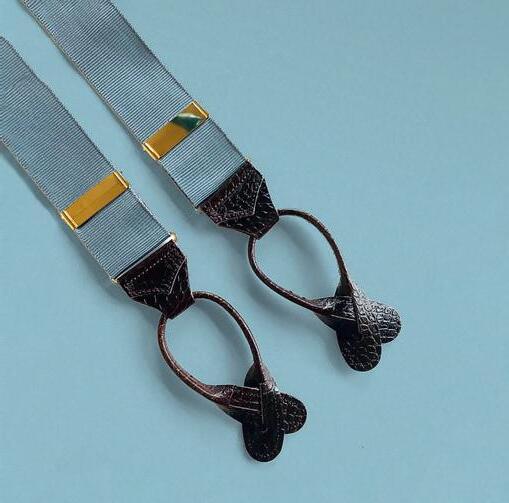

e nostalgic scent of pomade, the luxurious sensation of beard oil being massaged into your skin, the momentary rush of adrenaline as a straight-edge razor makes contact with your throat… a wet shave is a pampering experience that’s hard to beat, whether you favour a Turkish barbershop or a more formal, Victorian-style gentleman’s grooming parlour: long synonymous with Mayfair, but these days found across the UK. e single blade of a straight razor achieves a wonderfully close, clean shave – far smoother than even the most sophisticated safety razor – and its “cut-throat” moniker imparts a pleasingly masculine sense of danger to this otherwise sybaritic pursuit, best enjoyed in a chic parlour o ering complimentary drinks along with facials and manicures. Wet shaving matches our desire for sustainability – stropped and honed a er every use, a straight-edge blade will last for years, unlike its disposable cousins – and this is a trend you can try at home, armed with a strop, a shaving bowl and plenty of hot water. Just stay relaxed, let the razor do the work, and maybe ask for a few tips from your trusty barber.

WHILE THE HEALTH-GIVING QUALITIES OF BREAST MILK ARE WIDELY ACCEPTED, STORING AND TRANSPORTING IT HAS ALWAYS BEEN A PROBLEM. NOW, AS DR SIONED JONES TELLS JOANNA WOLFARTH, THINGS ARE ABOUT TO CHANGE
Breast milk, sometimes referred to as “liquid gold”, has long been celebrated for its exceptional nutritional and medicinal properties, and was even used as a remedy for various ailments, from at least the time of the Egyptians onwards. Until relatively recently, human breast milk was thought to be sterile, but we now know it is, in fact, full of bacteria that are the single most important factor in developing the infant gut and training the immune system. Colonisation of these bacteria in the infant gut can reduce the risk of obesity, diabetes, allergies, asthma and other immunerelated diseases. But it’s only now that researchers are looking into the precise composition and functions of these bacteria.
“It’s a perfect example of women’s health being underfunded, underresearched, and overlooked,” says Dr Sioned Jones, co-founder and chief operating o cer of BoobyBiome, a biotechnology start-up based at the UCL Great Ormond Street Institute of Child Health. BoobyBiome aims to revolutionise infant-feeding by focusing on the breast milk microbiome.
Jones and her co-founders, Dr Lydia Mapstone and Dr Tara O’Driscoll, met as PhD students at UCL and found they shared a frustration over the lack of attention given to the human milk microbiome. In 2019, they began analysing milk samples donated by women across the UK, building a first-of-its-kind database of the breast milk microbiome, and a biobank containing proprietary functional bacteria strains unique to breast milk. By looking at how these strains interact, the team managed to identi a core set of bacteria that would most benefit babies without access to breast milk.
However, cultivating these bacteria in a laboratory setting proved di cult. “We really struggled,” Jones recalls, “but we soon realised that these bacterial strains are very sensitive to oxygen because they thrive inside the mammary gland or infant gut. Were we destroying these microbes when transporting and storing this milk?” e team developed a device to mimic conditions inside the gut and mammary gland. eir hunch was correct. “We split the milk sample in the lab, placing one half in the device. e device preserved significantly more colonies. at was our ‘wow’ moment.”
Set to launch in 2025, the device, now known as the Bubble, helps preserve beneficial microbes and prevents pathogen growth in expressed breast milk – giving it immediate global potential. As Jones explains, “ e
Bubble extends milk shelf-life at room temperature, which could have a significant impact in countries where women may need to express milk but lack access to reliable refrigeration.” e company is also working with clinicians to get the device into healthcare settings, where it could benefit babies in the NICU (neonatal intensive care unit), who are reliant on expressed milk.
e team is also creating a scientifically validated supplement containing a core of beneficial bacteria from the breast milk microbiome. Its aim is to close the disparity in infant nutrition by ensuring that every baby, whether breastfed or not, gains access to this core breast milk microbiome. “Many companies market products without testing them on infants. We are designing trials and will launch the supplement only a er validating its e cacy,” says Jones. Behind the organisation’s playful name, BoobyBiome is grounded in science.
Today, while the mantra “breast is best” is widely accepted, not all parents can, or choose to, breastfeed. And whatever your choice, it seems feeding our babies can be a complex and emotive topic. e UK has some of the lowest breastfeeding rates in the world. Although almost 80 per cent of babies are breastfed for their first feed, these rates decline sharply over the first six weeks, with just 0.5 per cent still breastfeeding at one year. Jones suggests that if more women were educated about the breast milk microbiome, they might continue to breastfeed for longer.
I’m not so convinced. Most women know breast milk has great health benefits, which is why so many start out breastfeeding. But we both agree that raising awareness of the long-term health benefits of the “liquid gold” microbiome should encourage governments to increase funding to provide the holistic support new mothers need. I ask Jones if she worries that educating parents about the delicate breast milk microbiome might exacerbate the already considerable guilt many new mothers feel. Her view is that we should all be forgiving of ourselves, while also taking note of what breast milk can do, and how to make best use of it. A er all, she reminds us, breastfeeding has always been with us, “but this research is new”.
Dr Sioned Jones will be one of the speakers at the Goodwood Health Summit in September 2024. See her work at boobybiome.com
CARVED INTO LANTERNS OR COOKED IN A PIE, PUMPKINS HAVE CROSSED THE ATLANTIC IN RECENT DECADES. BUT, ASKS JOHANNA DERRY HALL, ARE THEY REALLY AMERICAN?
Perched on porches, glowing with flickering candlelight against the darkening days of late October, carved pumpkins seem to have gradually become more popular over several decades in the UK, and are now a quintessential autumnal sight on our doorsteps and gateposts. It’s estimated that 15 million pumpkins are grown in the UK every year, planted in May, ready to be harvested throughout the autumn.
e tradition of carving lanterns for Halloween is wildly popular in the USA, but it does not originate there. Its roots lie in Mexico, where pumpkins were an important food source, as well as being frequently used in rituals and celebrations. During the Aztec festival of Huey Tecuilhuitl, for example, pumpkin-based dishes were prepared as o erings to the gods.
e New World explorers of the 16th century introduced pumpkins to Europe, and it was the French who first brought them to Tudor England. From that point on, they were quickly absorbed into the cookbooks of the time and used in soups and pies.
Americans lay claim to that staple of the anksgiving dinner table, pumpkin pie, but some believe it may have English roots. e earliest published recipe for an American-style pie does come from Amelia Simmons’ 1796 book American Cookery, but there are mentions of a pie filled with alternating layers of pumpkin and apple in Englishwoman Hannah Woolley’s book e Gentlewoman’s Companion, published in 1670.
Meanwhile, the influence of ingredients brought to Central America by the Spanish conquistadors shaped a culinary fusion in Mexican cuisine that created, among other dishes, Calabaza en Tacha. is delicacy –essentially a pumpkin covered in thick sweet syrup – is o en served on Día de los Muertos, the Mexican equivalent of Halloween.
e transatlantic pumpkin exchange does not end with the culinary. e practice of lantern-carving is believed to be based on an Irish myth
about a man named Jack who tricked the devil several times and ended up cursed to roam between the planes of good and evil with only a lantern made from a turnip to guide him. e Irish, when they emigrated to America, took with them the tradition of carving turnip Jack O’Lanterns for Samhain, the Celtic holiday which falls on or around Halloween. But instead of turnips, they used what they had to hand: pumpkins.
Today, this practice has once more crossed the Atlantic. Farmer Caroline Harriott has been growing pumpkins at Lychpole Farm, near Lancing for the last six years. is year her team has sown 60,000 plants for people to come and pick their own. “It’s really popular,” she says. “People invariably go away with a wheelbarrow full of ten pumpkins, squashes and gourds.” For Harriott, it’s part of a wider diversification of agriculture and a way of showing people what farming is all about. “ ey get a snapshot of what a traditional mixed farm looks like, with cattle, sheep and crops. We can tell people about the hedges and how we manage the land to store carbon.”
Despite their vegetable-like appearance and usage, pumpkins are actually a fruit – part of the Cucurbitaceae family of plants that also includes cucumbers and melons – and they come in more shapes and sizes than purely large and orange.
“We have ‘traditional orange pumpkins’,” says Evie Gilbert from Dell Quay, a Pick Your Own farm near Chichester. “But we also have ‘ghost’ pumpkins, which are white and tend to be smaller; munchkin pumpkins, which are very popular either on their own or added into a creative Halloween display; and a mixture of squashes such as carnival squash and baby boo pumpkins, which are beautiful in an autumnal display.”
Whether as sweets, soups, pies or lights, from one side of the Atlantic and back again, when it comes to autumn produce, pumpkins truly are king of the season.

WHAT IS THE “REGENERATIVE WOOL” MOVEMENT AND WILL IT CATCH ON? SOPHY GRIMSHAW FINDS OUT WHY THERE’S MORE TO QUALITY KNITWEAR THAN HOW IT FITS AND FEELS
In 2024, a clutch of articles appeared in the UK press heralding the rise of “regenerative wool”. BBC coverage described the term as “the new green buzzword in the fashion industry”, while Vogue declared that “regenerative wool is the future of your wardrobe”. Both featured the example of a British-based luxury wool brand, Sheep Inc. Meanwhile, progressive fashion houses including Stella McCartney bear the trademark of Nativa, a brand whose natural fibres, including wool, are “sourced using regenerative approaches”. But what exactly is regenerative wool?
“Regeneratively farmed wool goes beyond sustainability and leaves the environment in an enhanced condition,” is how Maria Estrada, global director of Nativa, puts it. “Regen [regenerative farming] improves the quality of the soil and restores natural biodiversity at farm level, resulting in better nutrients, cleaner water and a healthier overall habitat.”
“ e term regenerative wool basically means really looking at how you source wool in the correct way,” adds Edzard van der Wyck, co-founder of Sheep Inc. “Wool is an amazing fibre: it’s suitable for every season, it’s so , it’s good against the skin. e real challenge, however, is how you source it.” He points out the problem that “the sheep is a methane-producing animal”, making it a potential contributor to the climate crisis, as well as the issue of animal welfare and other environmental concerns. “Whereas with food, brands know that people

are increasingly paying attention to what they buy – was it a happy chicken that laid this egg? – the clothing industry seems slightly behind.”
He and his Sheep Inc co-founder Michael Wessely always conceived of the knitwear business as being built on sustainable credentials first and foremost (Wessely is a former data analyst; van der Wyck has a background in disruptive online fashion brands). “Soil is the unsung hero of the current climate crisis in the sense that if you let soil rest, and you don't continuously turn it over, it can actually hold a lot of carbon,” continues van der Wyck. “It becomes a big carbon sink. So we only source wool from regenerative farming stations where, through the methods they adopt, we are able to have a positive impact at the source of our wool – the farm will sequester far more CO₂ than it produces. For every 1kg of wool that we source from these farms, about minus-14 kg of CO₂ equivalent is sequestered. We have a material that is actually carbon negative.”
What may surprise some is that the regenerative farms from which this British brand sources its wool are in New Zealand. However, van der Wyck is confident that he and Wessely can make a rock-solid case for their green credentials with these choices, even if at a glance the travel (albeit by ship, not by air) “seems counter-intuitive”. e merino sheep that the brand uses for its wool are also adapted to the kiwi climate, “which is a lot harsher in the winter and a lot warmer in the summer [than the UK]”, says van der Wyck. “So the wool has to adapt to those two extremes. Here, we have a more temperate climate which means that in the UK, merino wool tends to degrade in quality.”
“Wool is an amazing fibre… the real challenge is how you source it”

HARRY HOLT, FARM MANAGER AT GOODWOOD ON THE DUTIES OF THE AUTUMN MONTHS
Summer is coming to a sad close at Goodwood Home Farm. On the arable side, there may be a little bit of harvesting to finish up in September, and we’ll be bringing in the straw bales, which we use to bed down the animals during the winter. We’ll also start ploughing some of the fields, drilling our “winter wheat”.
In October we’ll start bringing in the smaller cows. We have around 850 beef cattle. As the nights start getting cooler, the ones who are younger than 12 months don’t want to be out in the cold at night – they need a bit more TLC. With the dairy cows, we also do some things differently as the season changes. The grass growth slows down, so we bring cows in during the nights as well, to make sure they are nutritiously fed on forage. We will still try to get them out during the day because there can be some nice sunshine.
Beyond farming methods, true “regenerative wool” should employ sustainable methods throughout the production process. In the case of Sheep Inc: “We scour the wool – to clean o dirt and residue – in a B Corp registered textile mill in Italy that uses renewable energy,” says van der Wyck. “We manufacture everything in Europe, with 100 per cent green energy. Our whole supply chain has a carbon negative impact, without having to buy carbon o sets.”
To emphasise this clean, green provenance, the brand also uses in-garment digital tech including NFTs, so that the wearer can view the garments’ production journey from farm to wardrobe. Similar techy entry-points are becoming a key tool in conveying other brands’ sustainability credentials. e wool choice and luxury price points of Sheep Inc don’t immediately lend themselves to a new model of mass consumption– £160 for a polo shirt isn’t fashion for everyone, though the brand hopes to lower prices over time. But the idea that wool is a commodity whose provenance should matter to us as consumers seems to be cutting through. Is demand for regenerative wool here to stay? Certainly van der Wyck is among those who are betting on it. “People are interrogating things that they didn’t used to,” he says. “Mindsets are changing.”
Sheep at Goodwood Home Farm are organically farmed and not bred for woolproduction, but excess wool when they are sheared is reused or disposed of sustainably. To find out more, visit goodwood.com/visit-eat-stay/farm-shop/organic-farming
As for the sheep, in autumn we’ll put the rams in with the ewes ready for getting the ewes pregnant. And one important thing that we do leading up to that is something called flushing the ewes. It’s an old farming term – it means you put the ewes on some very good, lush grass. This helps with their ovulation and improves fertility. We’ll be looking to put the rams in around Bonfire Night, with one ram for every 40 ewes. Overall, autumn is a time of slow transition, getting ready for winter. With some animals coming inside, it feels good knowing we’ve got all our forage or straw and the grain in and ready. The rush of harvest is over. Learn more about farming at Goodwood, and the organic produce available, at goodwood.com
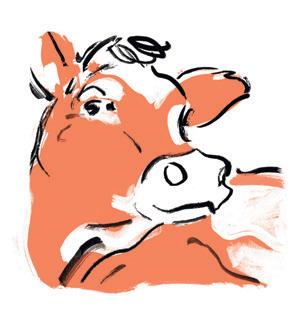
















SEPTEMBER & OCTOBER
TEA & TOUR AT GOODWOOD HOUSE
Goodwood House combines the glamour of a great English country house with the warmth of a family home. A er a guided tour of the House and its significant private art collection, visitors can enjoy a delicious a ernoon tea in the spectacular Ballroom.
5 SEPTEMBER
FREDDIE MARCH SPIRIT OF AVIATION LAUNCH PARTY
On the eve of the Goodwood Revival, members of the Goodwood Aero Club and Goodwood Road Racing Club are invited to the Freddie March Spirit of Aviation launch party. is year’s display of jawdropping vintage aircra focuses on those with links to Operation Overlord, as part of the Revival’s tribute to mark 80 years since the D-Day landings.
6 SEPTEMBER REVIVAL GOLF
With the whole estate taking a step back in time over the Revival weekend, Downs will play host to the Revival golf challenge. Designed in 1914 by golfing legend James Braid – architect of Gleneagles and Carnoustie – it is the perfect setting for a field of golfers dressed in 1940s, 50s and 60s attire and playing with hickory clubs.
6-8 SEPTEMBER
GOODWOOD REVIVAL
e world’s greatest celebration of historic motor racing and second-hand culture: see p101 for full details.
21 SEPTEMBER, 12 OCTOBER
GOLF AT GOODWOOD ORDER OF MERIT – RACE TO ANTOGNOLLA
e 2024 Order of Merit draws to a close with the final fixtures of the season. Who will come out victorious?
21 September
e Caledonian Cup – e Downs
12 October
Lord Esme Cup – e Park
13 OCTOBER
SEASON FINALE
e last fixture of Goodwood’s horseracing season – in between the races, enjoy music, fire pits and toasted marshmallows.
24 OCTOBER
NED’S FUND EVENING LECTURE –AN EVENING WITH FRANK GARDNER
An evening with the BBC Security Correspondent Frank Gardner, with proceeds donated to Ned’s Fund, set up in memory of a brilliant young man who took his own life in 2017. On arrival, guests will enjoy drinks and canapés, followed by a tour of the House’s state apartments.
FROM 26 OCTOBER
2025 TICKETS GO ON SALE
With the excitement of this year still fresh in our memories, we’re already counting down the days until 2025. Early bird tickets for next year’s motorsport events will be on sale from 26 October to members, 28 October to fellows and 4 November to the general public. Tickets for Goodwoof are already available.
12-13 April
82nd Members’ Meeting presented by Audrain Motorsport 17-18 May
Goodwoof 10-13 July
Festival of Speed presented by Mastercard 12-14 September
Goodwood Revival
31 OCTOBER, 1 NOVEMBER
FOREST ADVENTURES WITH THE GOODWOOD EDUCATION TRUST
School-age children are invited to a full day of Forest Adventures. Play, explore and enjoy nature-based and bush-cra activities such as tracking and trailing, den building, natural cra s, woodland jewellery, leaf printing and wand making.


The 2024 Revival, which takes place over the weekend of 6-8 September, is an event like no other. Staged in the evocative time capsule of the 1940s, ’50s and ’60s, with visitors completing the scene by dressing in appropriate period attire, it manages to be at once unapologetically nostalgic and thoroughly modern in its outlook.
e event’s “Revive & rive” ethos is inspired by a time when “make do and mend” was a way of life rather than a casual slogan. is message – increasingly relevant in the present day – is celebrated with a hub of second-hand style, as well as the lovingly maintained classic cars and motorcycles that fill the paddocks and take to the track. e result is a joyous melting pot of cultures, with immersive experiences around every corner. Visitors are as likely to smile wistfully at a reminder of a past life as gasp at the world’s most valuable historic cars being raced, or laugh at a piece of quirky theatrics. is year’s highlights will include a visit by vintage style icon Dita Von Teese; a tribute to the only man to win world championships on two wheels and four, John Surtees; a playful celebration of the Meyers Manx beach buggy and a parade to mark the 80th anniversary of the D-Day landings. Plus, all the usual staples: an amazing line-up of races with a who’s who of famous drivers; a vintage market and funfair; a drive-in cinema; the Earls Court Motor Show; the Freddie March Spirit of Aviation concours d’elegance and music to dance the (day and) night away.
“Unique” is an overused word, but here it is absolutely appropriate. e Goodwood Revival is the world’s greatest celebration of historic motor racing, vintage fashion and second-hand culture, and a weekend not to be missed. ere is simply nothing like it.








Experience and discover more with the 2026-2027 New Voyage Collection and the refined pleasures of the All-Inclusive Regent Experience. Discover the rich and diverse colours of our world’s cultures and landscapes as we unveil new, breathtaking voyages across the globe. Each destination is a vibrant story waiting to be told, inviting you to explore, experience, and be inspired. Embrace the magical atmosphere of journeys aboard our award-winning fleet and book your next adventure today.


22 SEPTEMBER, 10 NOVEMBER
ACTIVE LONGEVITY RETREAT
is retreat, developed from our Gut Health Programme, focuses on longevity and pro-ageing. As we begin the journey of habit change and how to live a full and vibrant life, we eliminate the concept that growing older means ageing. Rooted in the profound connection between gut health and longevity, this five-day wellness programme is designed to help you maximise your healthy years and embrace pro-ageing as a conscious journey towards revitalisation.
13 OCTOBER, 3 NOVEMBER GUT HEALTH PROGRAMME
Nourish, nurture and revitalise your physical and mental health on this fiveday programme. From energy regulation, weight management and immune response to stress resilience, sleep quality and a happy brain, the tenets of good health start in the gut. A combination of nutritional advice, results-driven therapies and specialist support will help you establish new, healthier habits for life.
15 NOVEMBER WIM HOF RETREAT
Wim Hof believes our modern lifestyles have disconnected us from the natural environment, meaning our age-old survival mechanisms are no longer triggered and that we’ve lost touch with our inner power. rough decades of self-exploration and scientific study, Hof has created an e ective way to stimulate these deep physiological processes and realise our full potential. Learn the three pillars of the Wim Hof technique – the breathing, the gradual cold exposure and the commitment – to become happier, healthier and stronger.
17 NOVEMBER
Our five-day programme of world-class specialist coaching in increased resilience, reduced stress and optimal gut health ensures a complete overhaul of your physical and mental health, for a body and mind that is primed for success. Goodwood has assembled industry-leading experts to equip you with clear goals, healthier habits and, ultimately, a sharper mindset with your specific needs at the fore.


Every picture tells a Goodwood story

FREDDIE MARCH AT GOODWOOD, c1950 Frederick, 9th Duke of Richmond’s passion for all things automotive inspired a legacy that lives on today at Goodwood. The grandfather of the current Duke, Freddie March, as he was widely known, was born in 1904, becoming the 9th Duke when his father passed away in 1935. Freddie (pictured above, behind the wheel of an Allard at an early Goodwood automotive event) was determined to write his own, decidedly 20th-century, script, which included carving out a life for himself as a racing driver and motor racing promoter. He knew he needed to prove his dedication to the sport, and he did, taking gold in a 1929 Brooklands time trial, winning the British Racing Drivers’ Club 500 in 1930 and the Double Twelve in 1931. But it was his idea of transforming a perimeter road around the former RAF airfield at Goodwood into a motor racing course that would change everything. Early events such as the Glover Trophy and the Goodwood Nine Hour sports car endurance races drew crowds, not to mention the era’s best-known drivers, laying the foundations for Goodwood’s evolution into the spiritual home of British motorsport.




